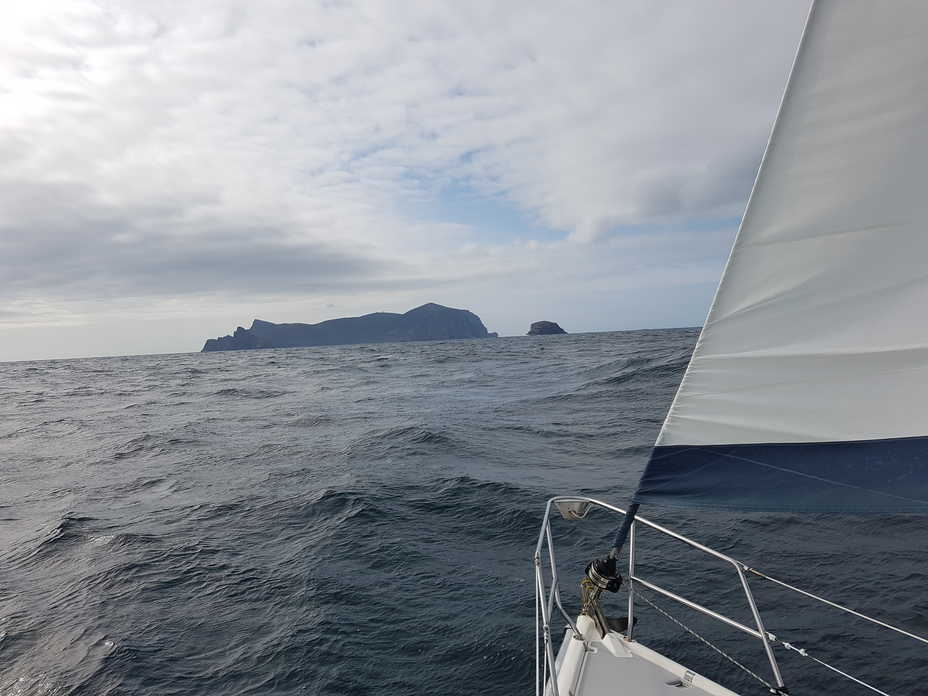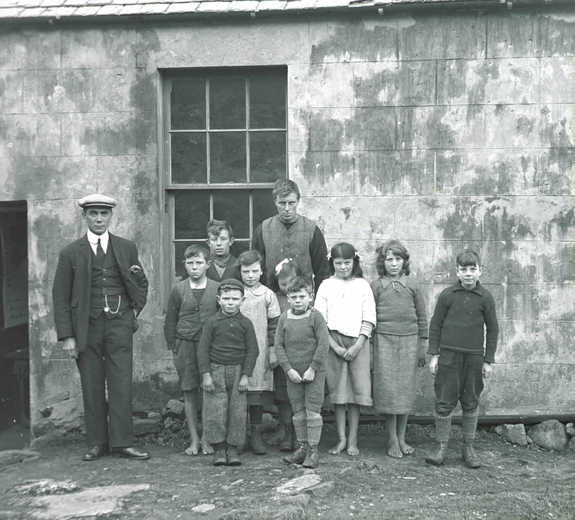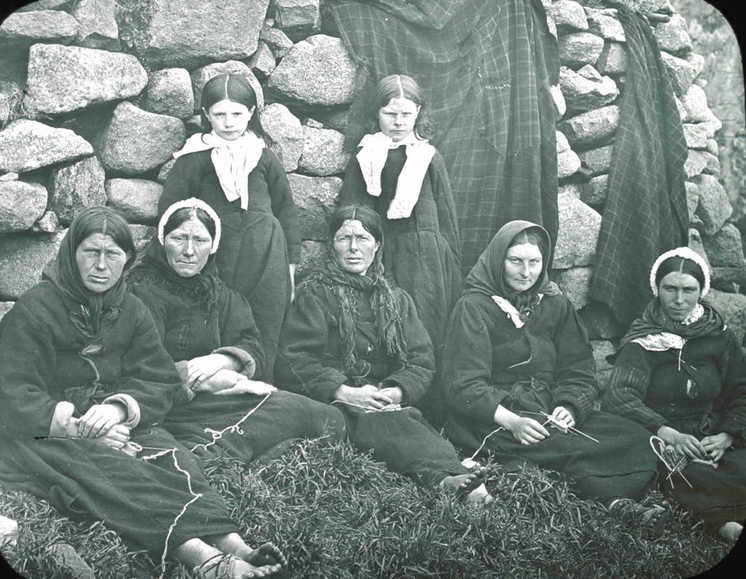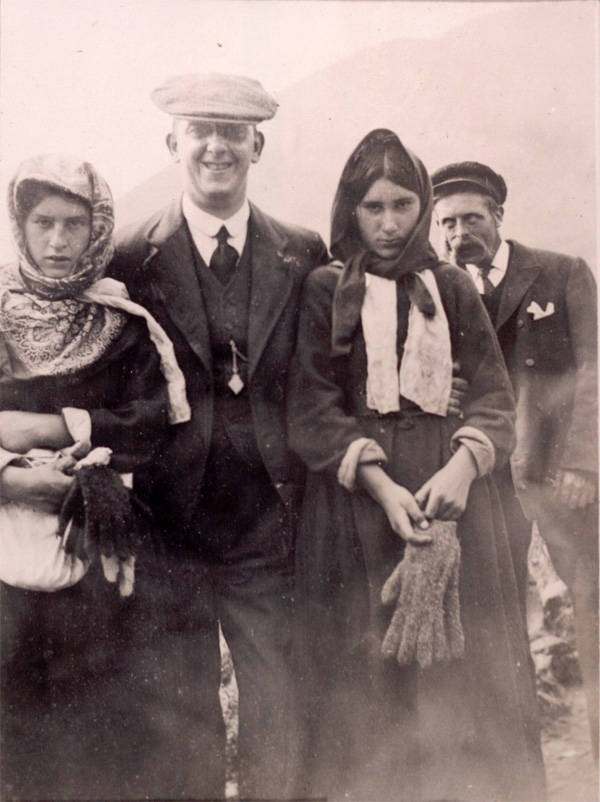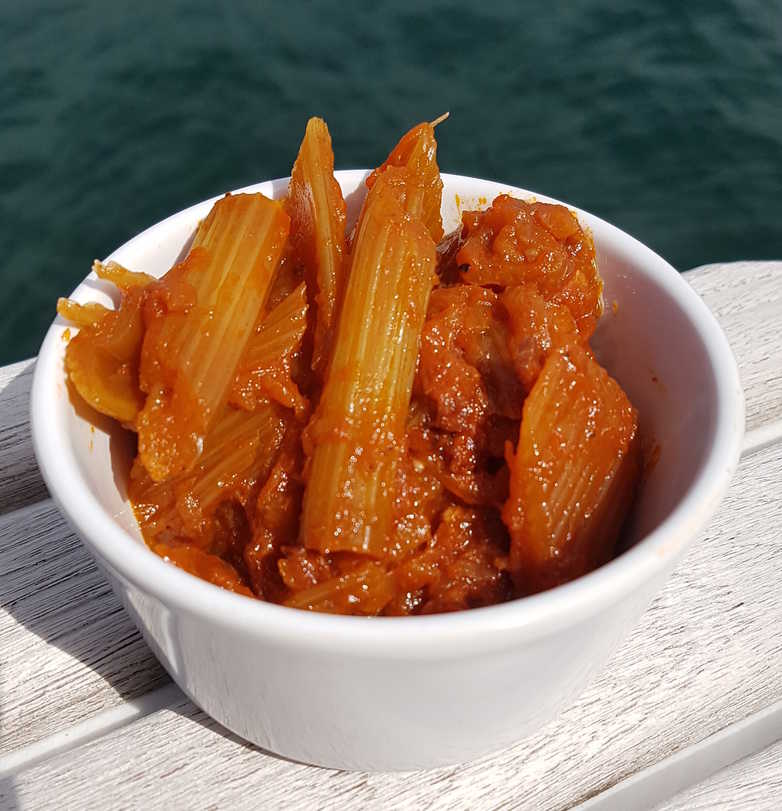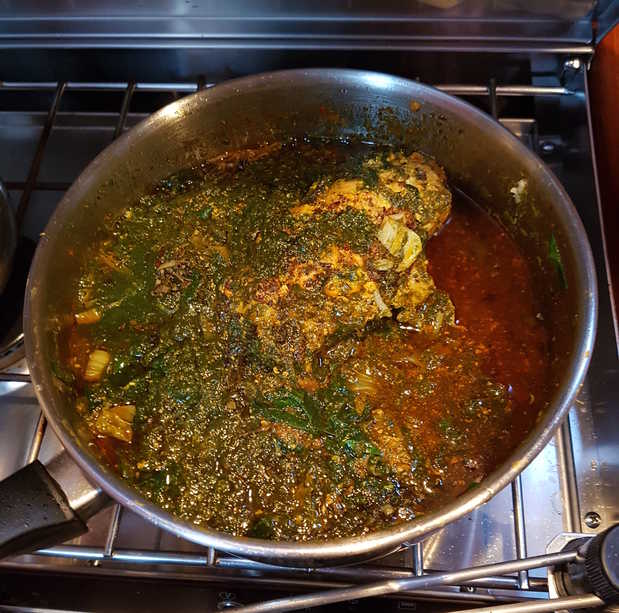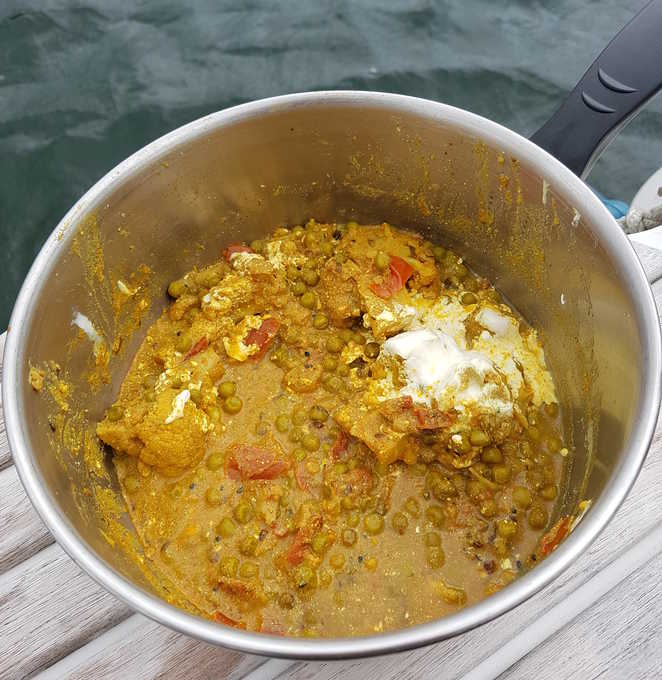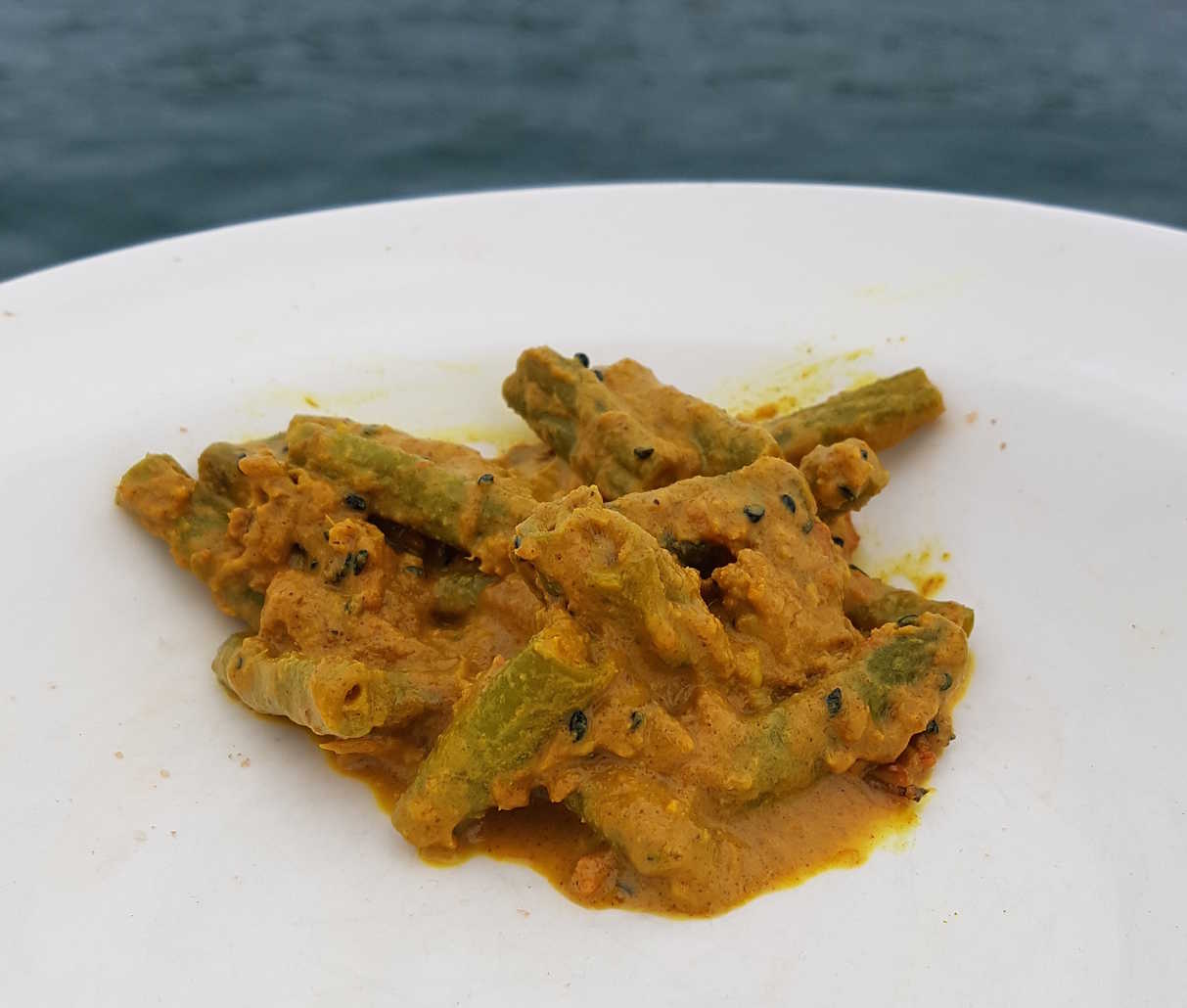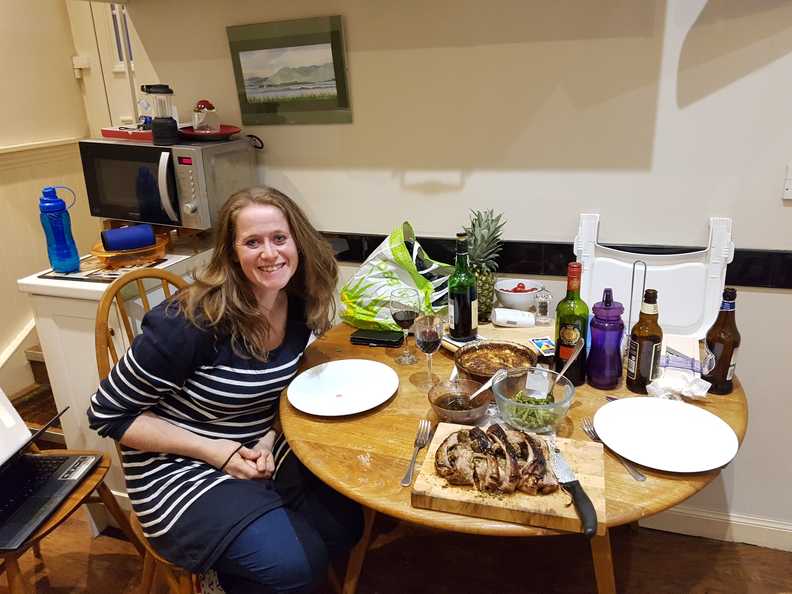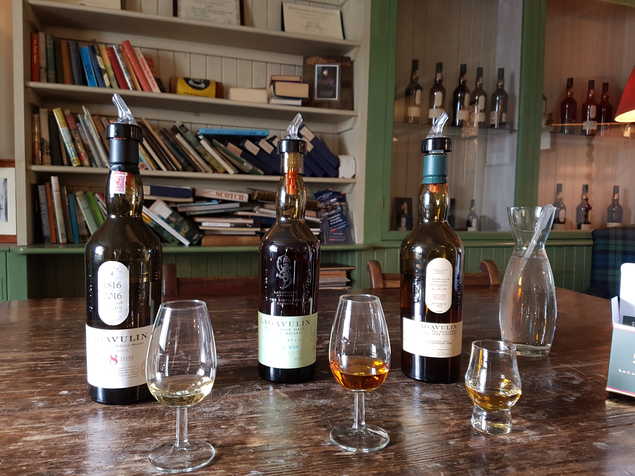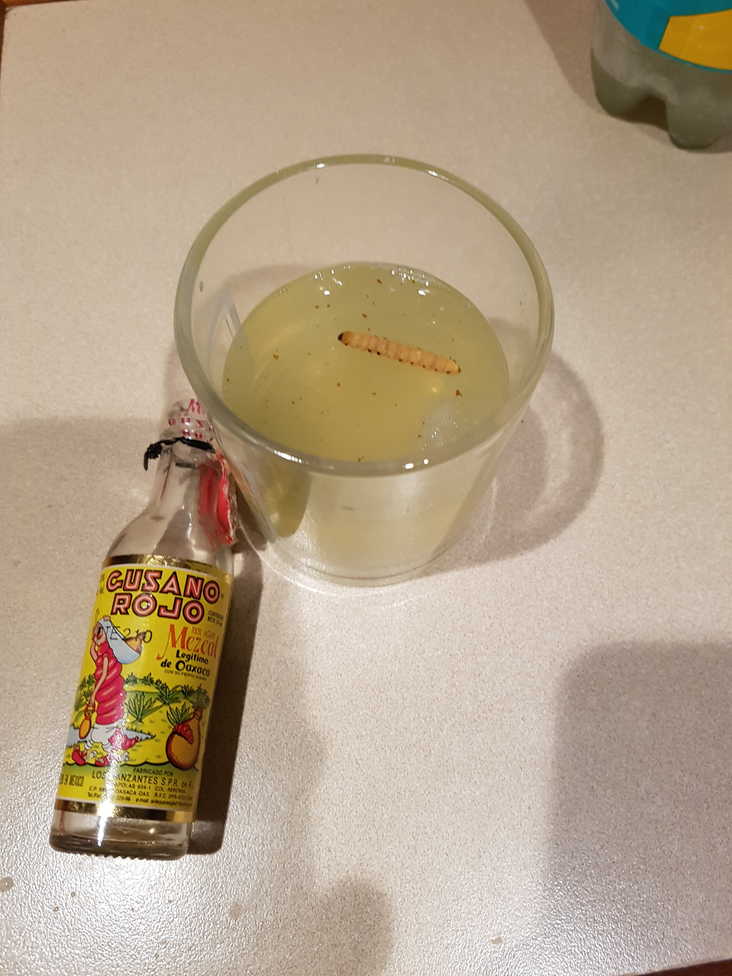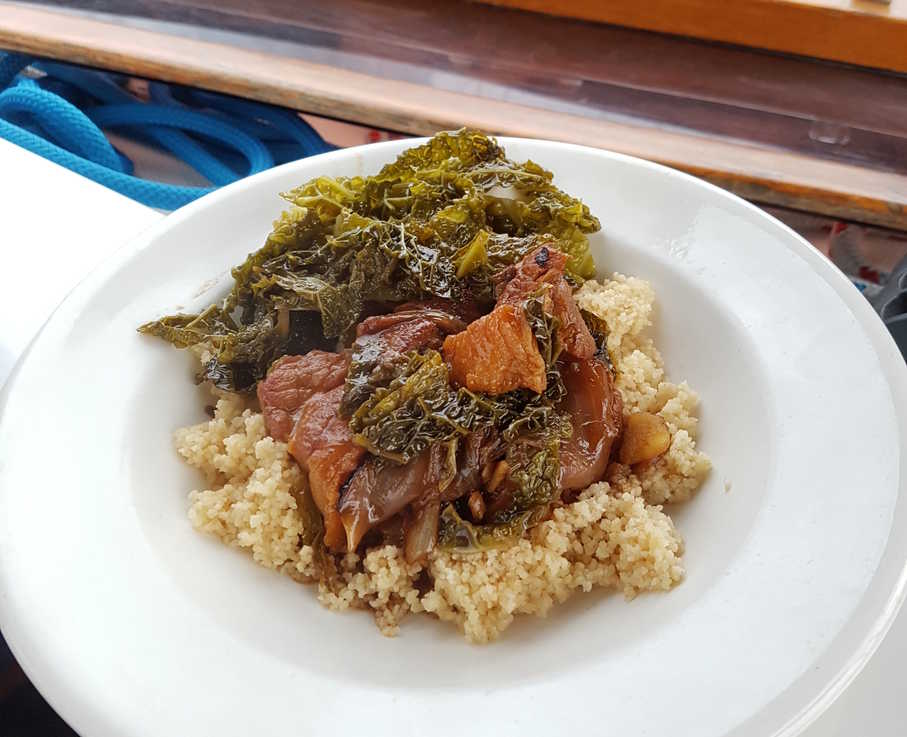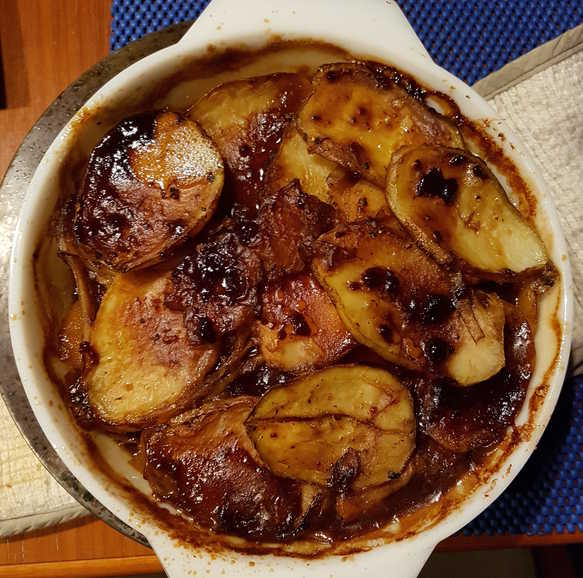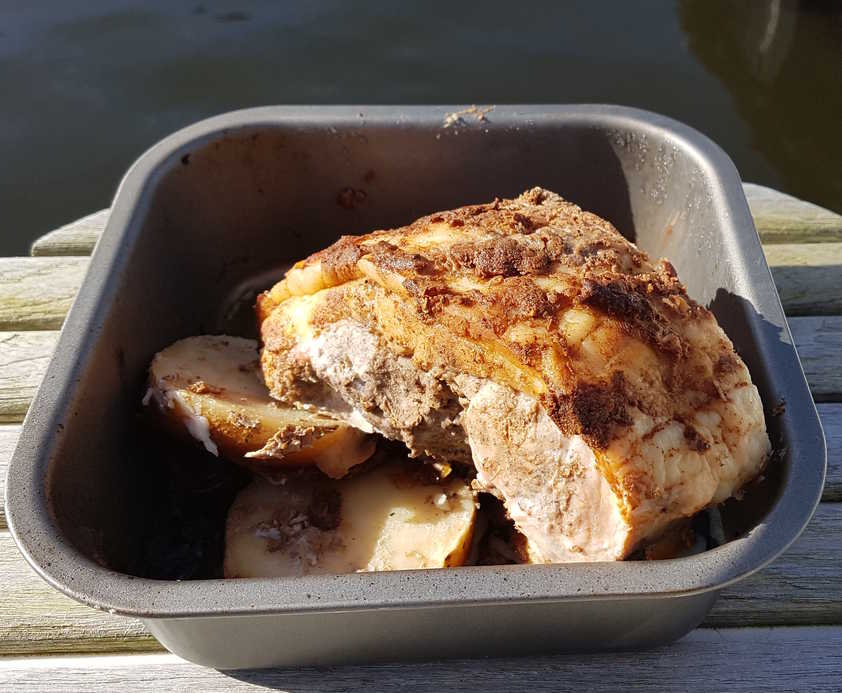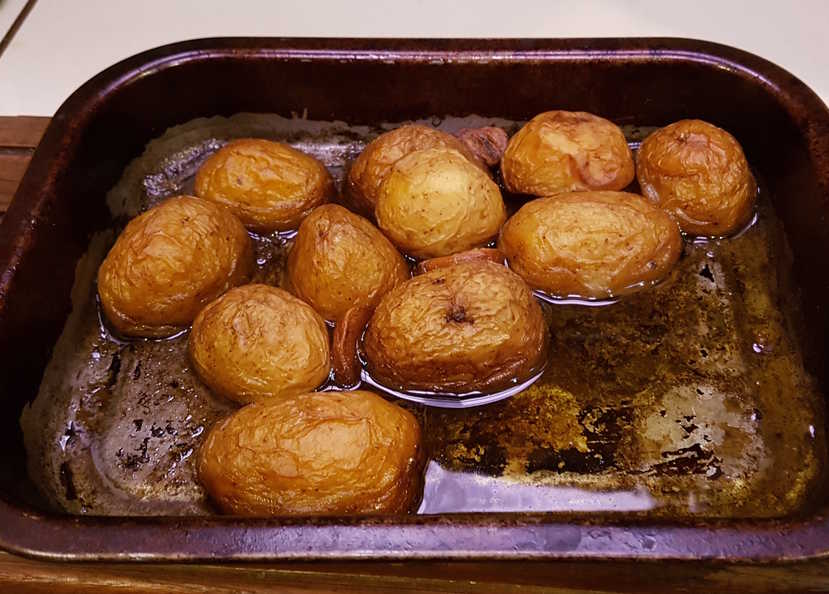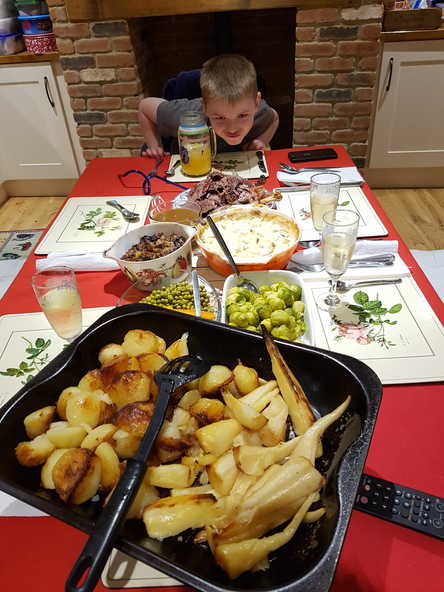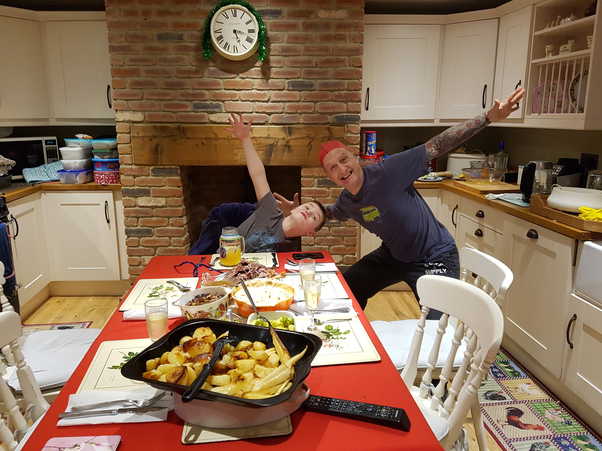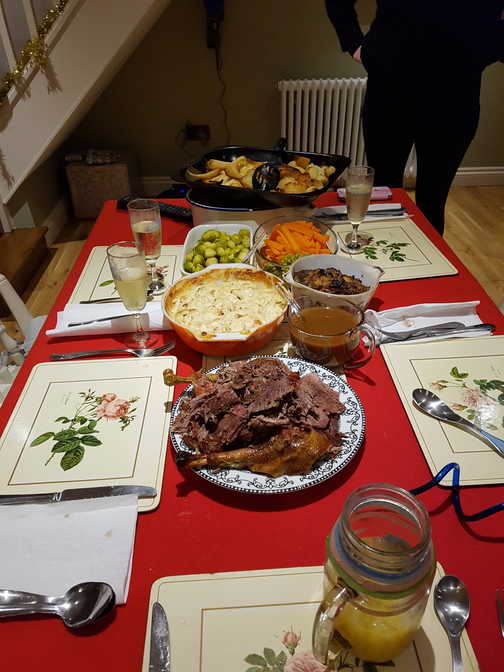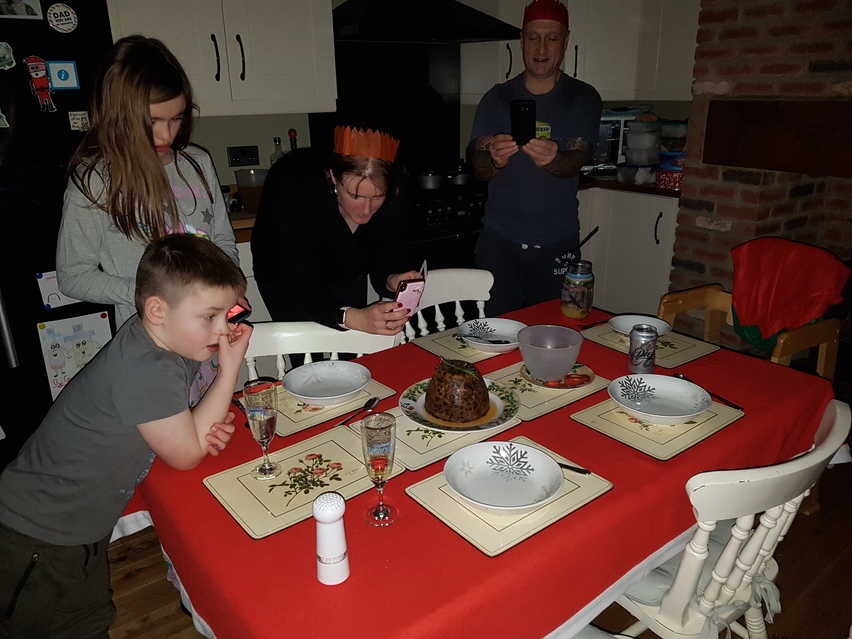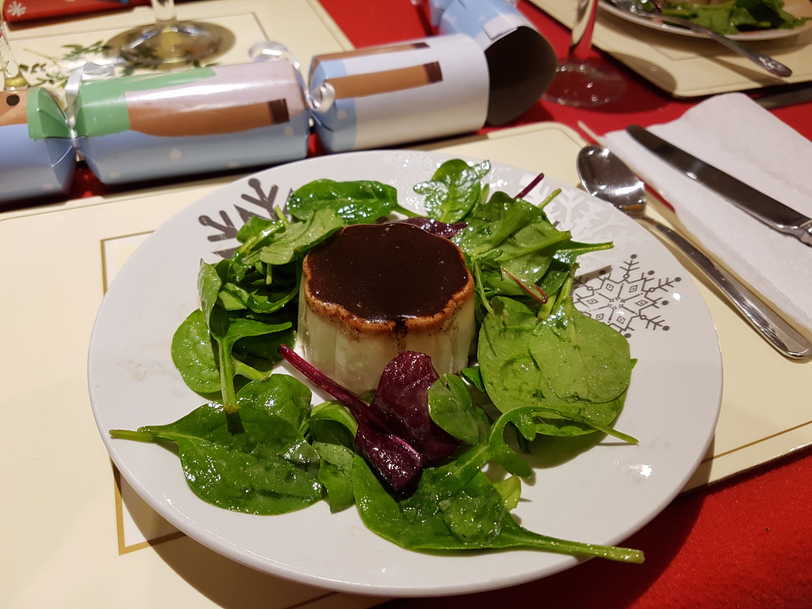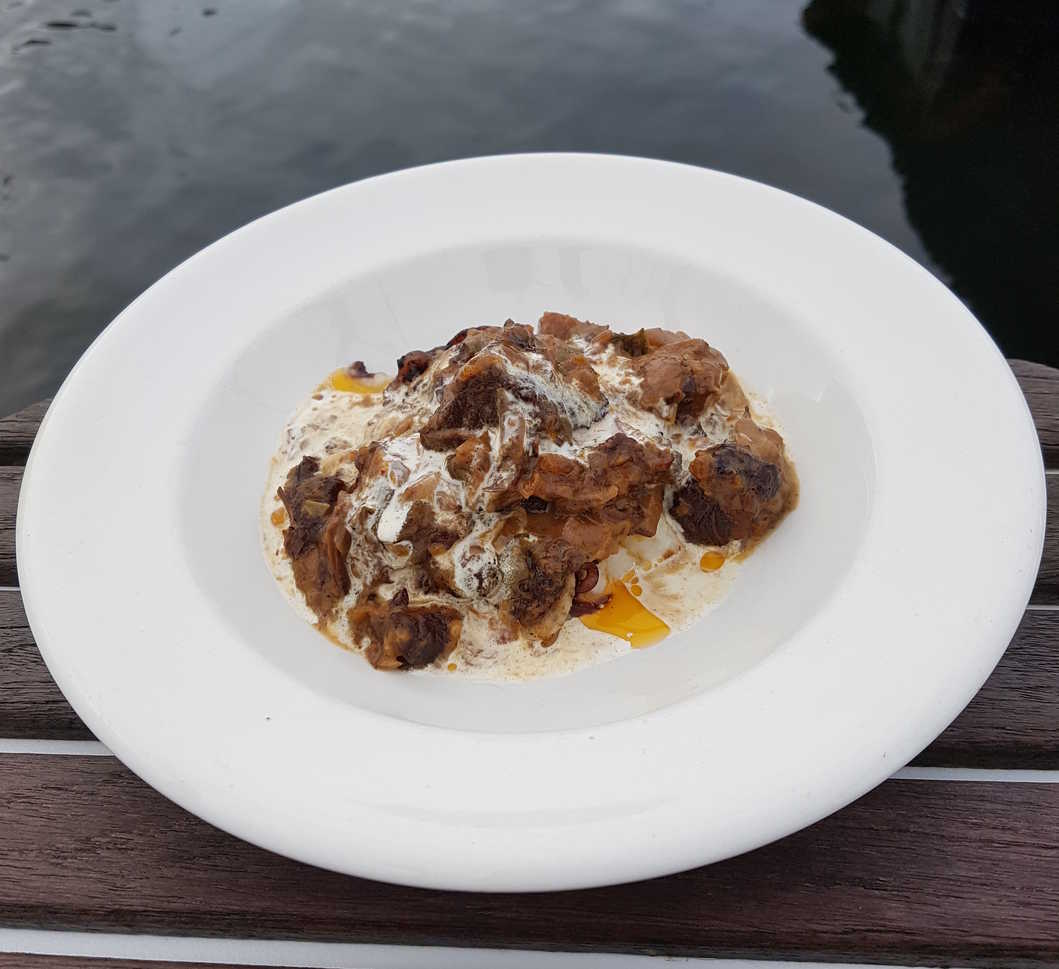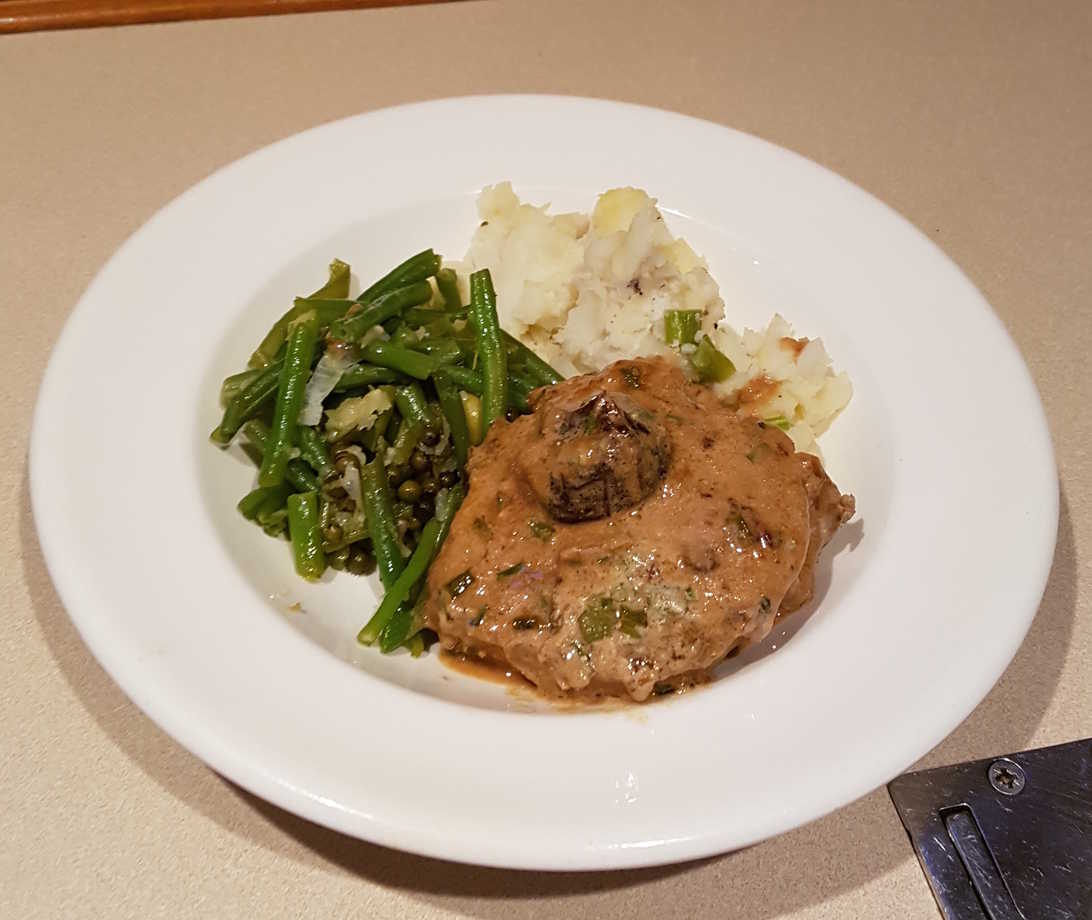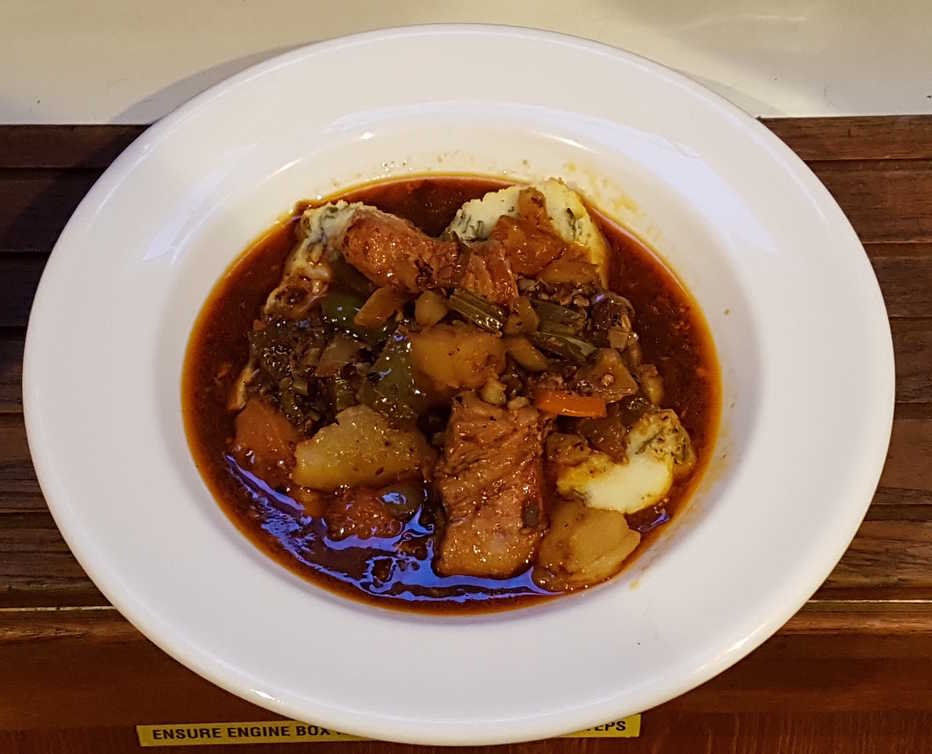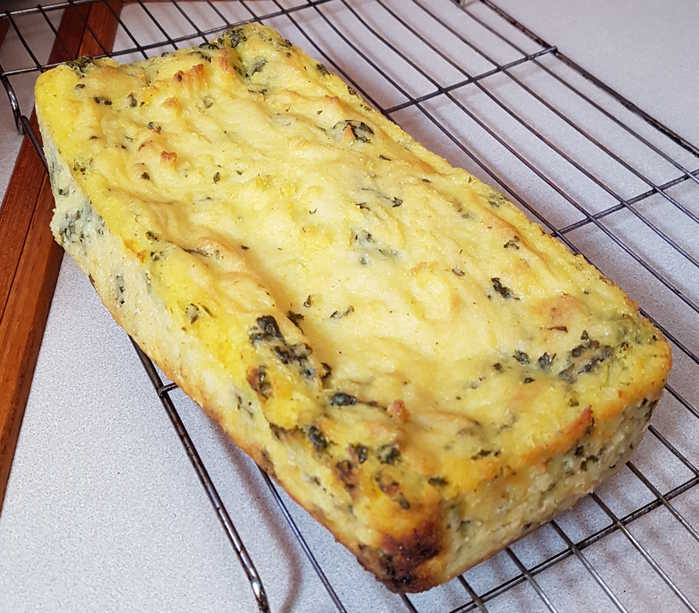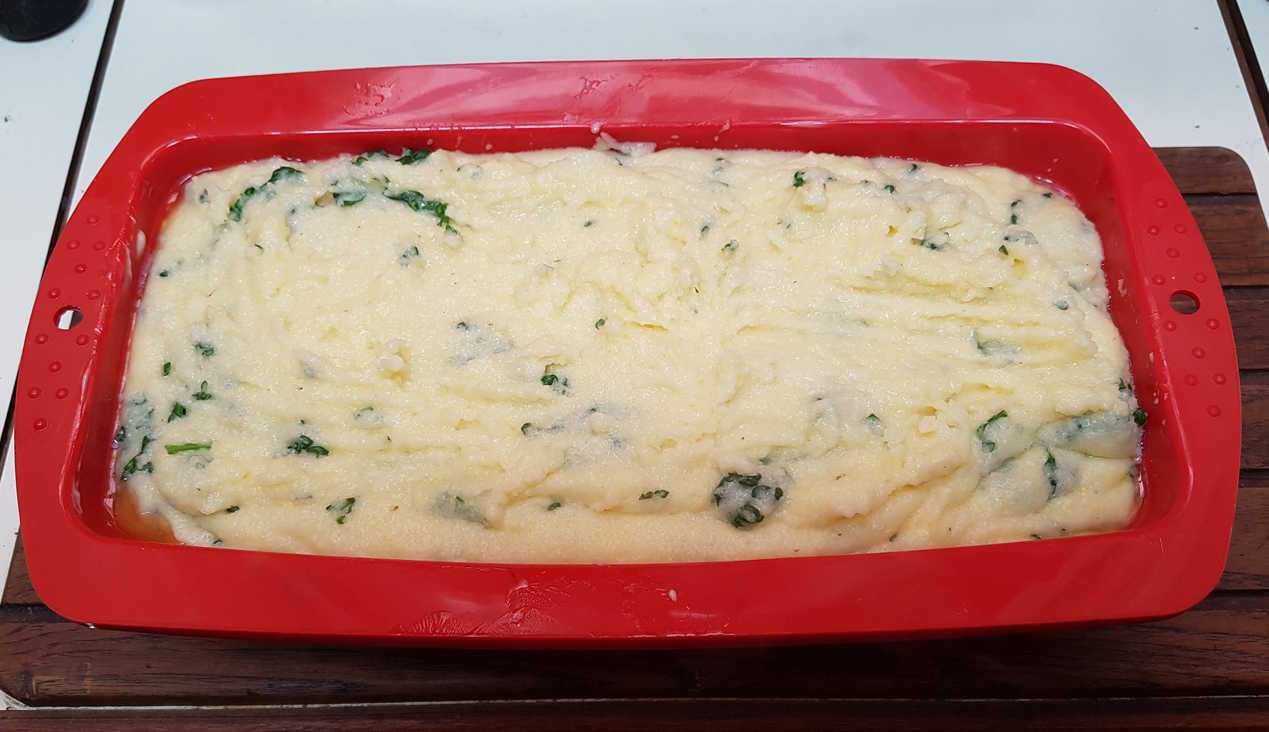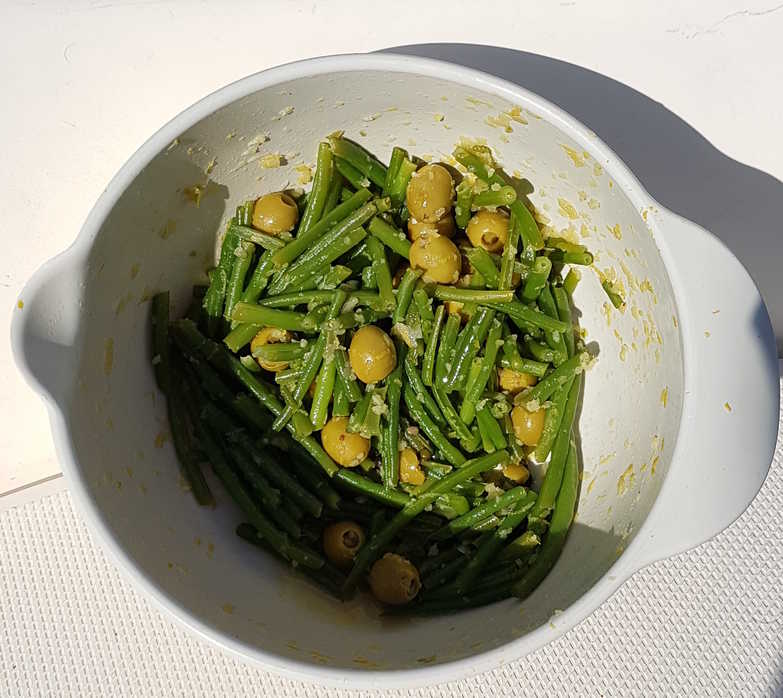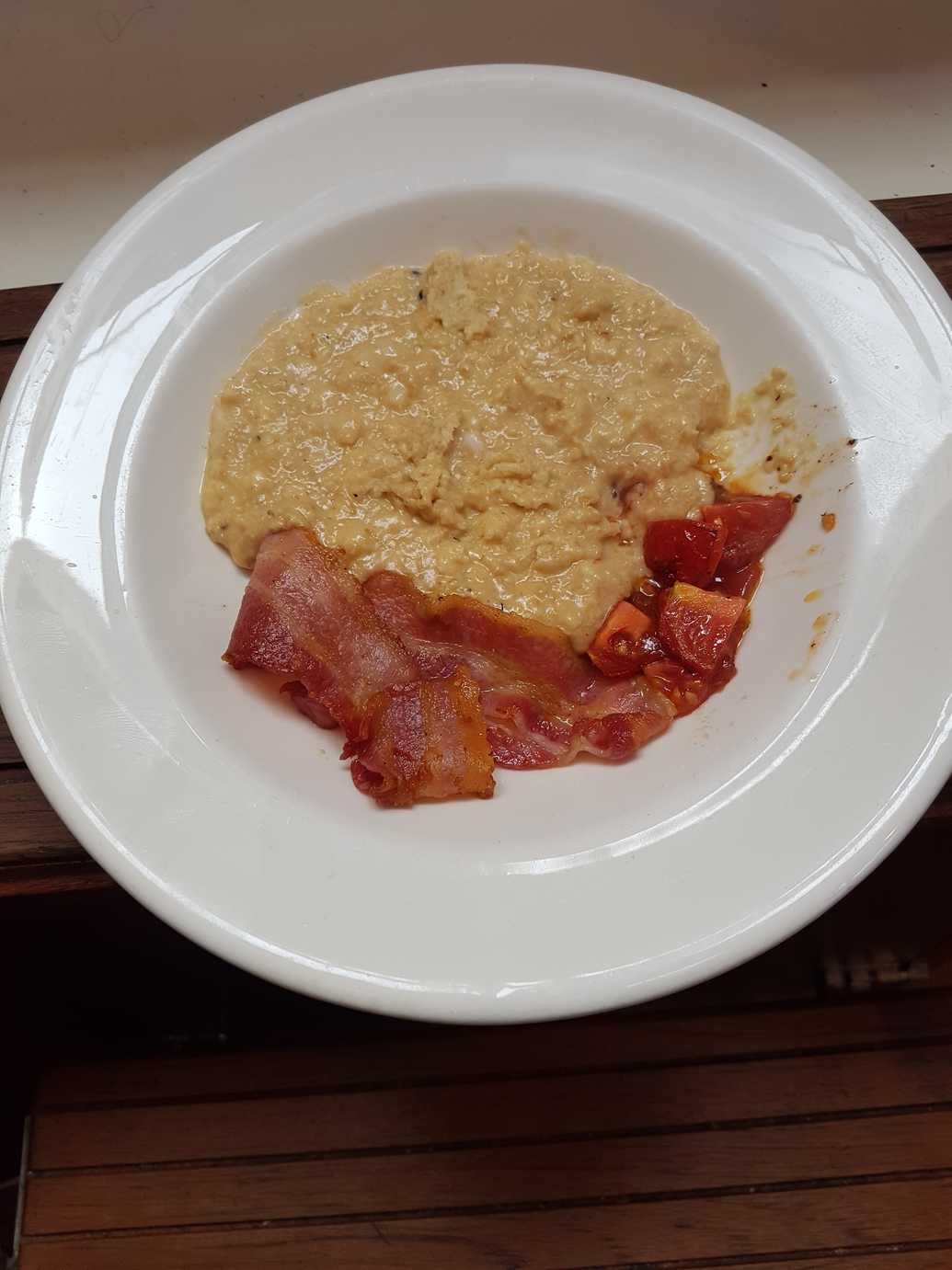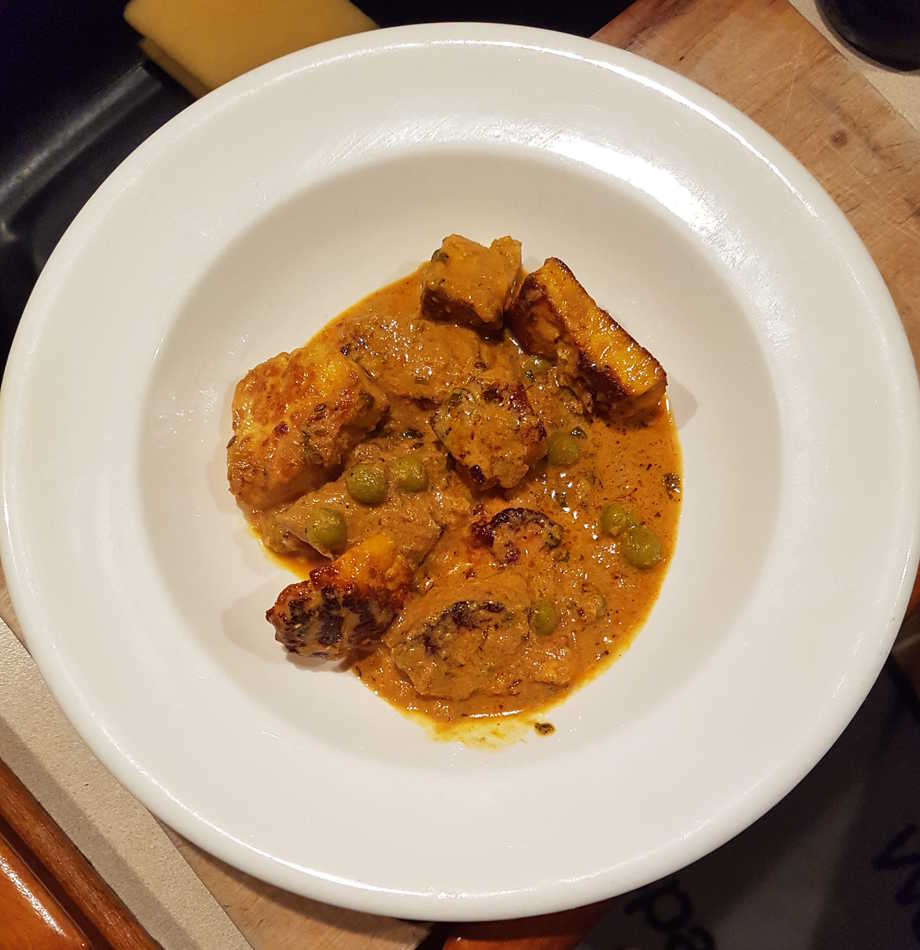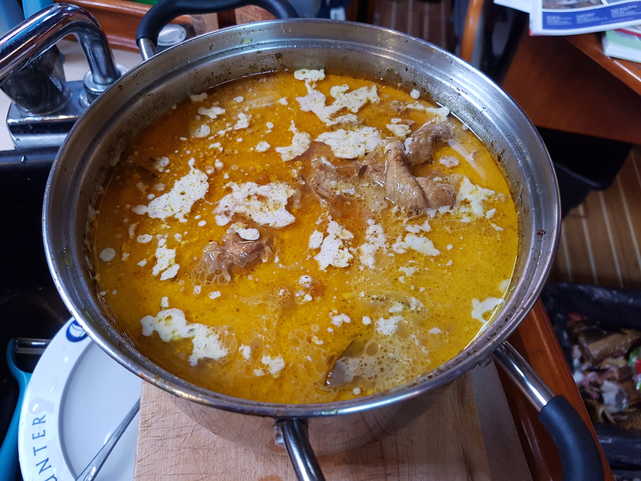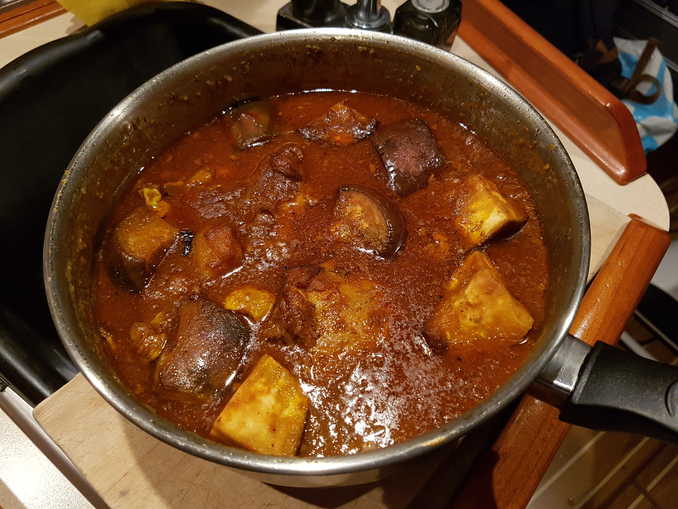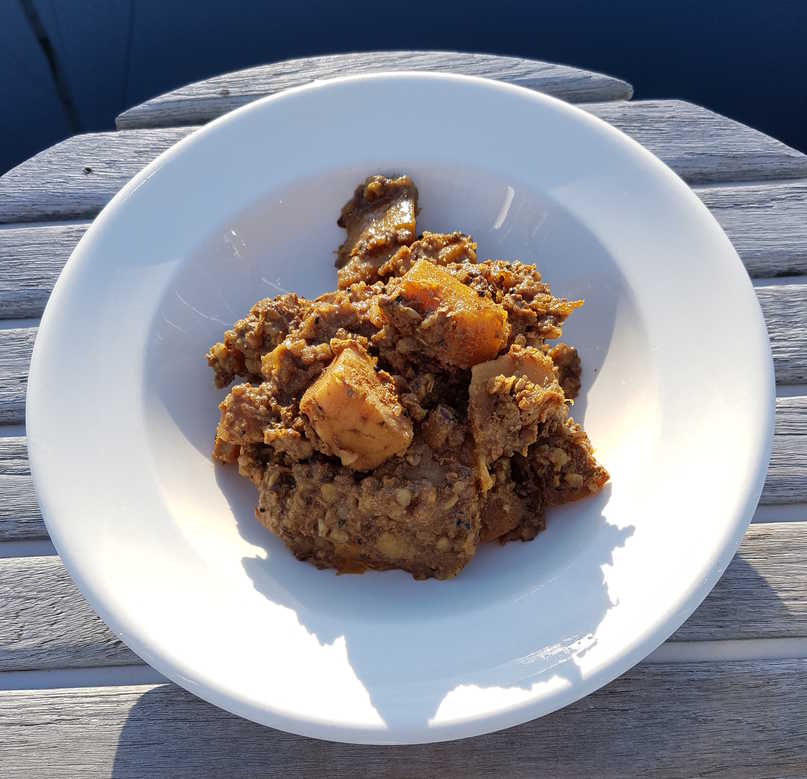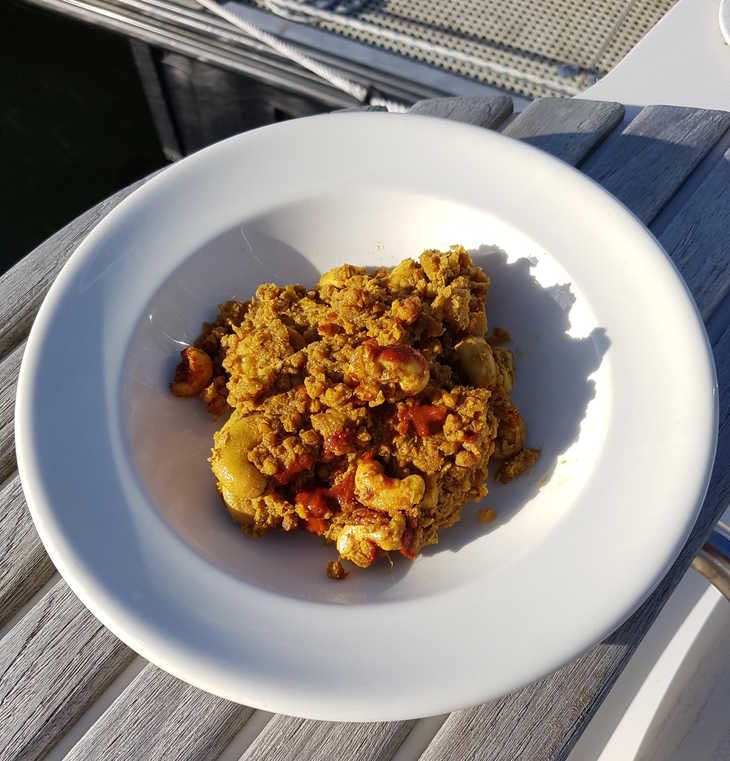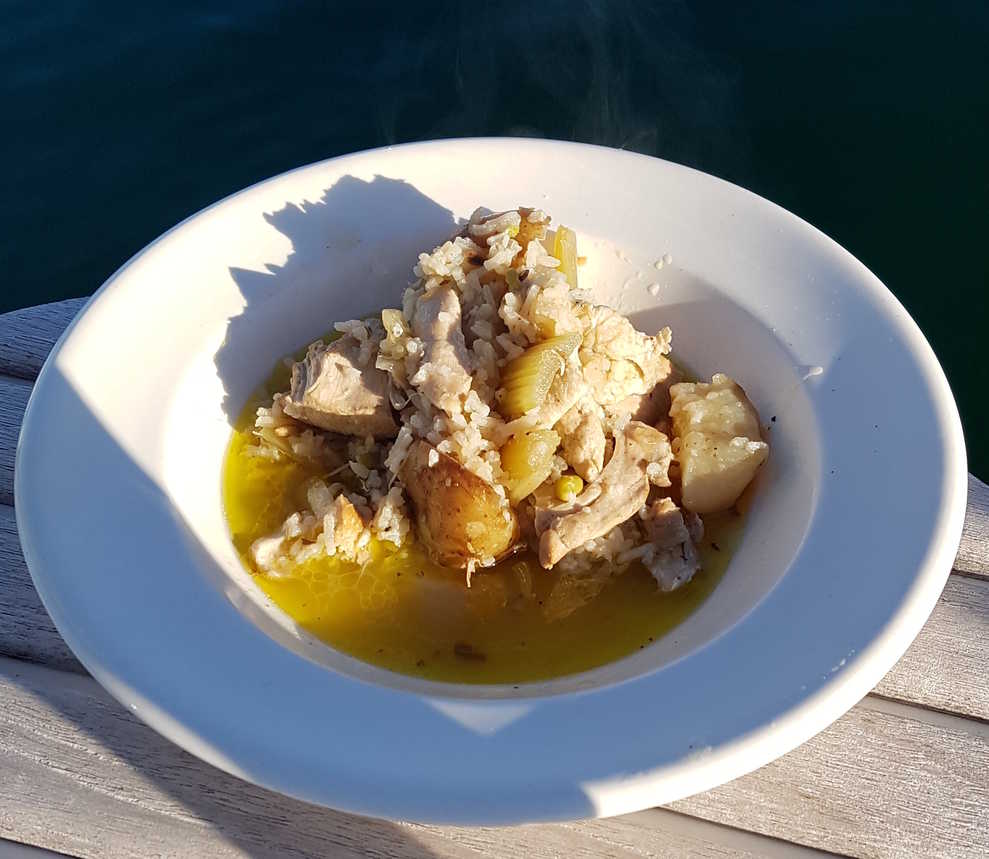
St. Fucking Kilda!

So I finally lived the dream - the secret dream of all British sailors: To make the passage out to the UK's nautical El Dorado, its salty Shangri La, its xenobathic Xanadu - the fantastically remote island archipelago of St. Kilda.
Not that St. Kilda is really all that far - it's only about 50 miles from the nearest safe anchorages on Harris, but still it is an exposed voyage out into the raw Atlantic with its risk of sudden changes in weather and seas. Plus you are starting from somewhere that's already pretty remote - the outer side of the Outer Hebrides. You don't get much more outer than that!
'Tis a wild and lonely place, ye ken.
My sail out there wasn't entirely straightforward, it ended up being a two day beat (natch), the first leg taking me massively southwards to the almost equally remote low-lying Monach Islands, where I anchored overnight, before finally being able to lay St. Kilda on the second day. And an exciting relief it is to finally see those sheer rocky cliffs rearing out of the empty ocean with their promise of a sheltered loch.
I anchored in the well-protected Village Bay, some distance off the old pier and the new slipway. The bottom is clean sand and I eventually got Harmony firmly secured, even though the convenient shallows were congested by a host of small buoys, and rowed ashore.
The St. Kilda radio operator was very welcoming, but asked me if I'd mind moving my yacht from where I'd anchored between the marker buoys which guide in their delivery ferry, landing building materials onto the slip. I declined, opining that they would probably manage to work around me.
She then gave me a fine introduction to the island and its surprisingly large population of birdwatchers, sheep taggers, archaeologist and the remaining small MOD contingent (as they dismantle the old barrack buildings). And to the excellent museum set up on the single street of drystone black houses where the original (and ancient) Kildarians resided in medieval squalor before the last 34 of them were shipped off to the mainland in 1930. Probably not a moment too soon - a funny-looking bunch of inbreds they were and the creepy old photographs in the museum still give off a very Wickerman vibe.
Then I spent a few pleasant evening hours hiking up the rocky hillsides and investigating the drystone cleats (St. Kilda is rich in stones) where the islanders used to dry their seabirds, eggs, bits of stringy goat and their peat. And used to live! at least in the bigger ones. Apparently they managed surprisingly little fishing due to the inhospitality of the local seas. Or possibly not so surprisingly.
And so to bed. I did ask if there was a pub. There wasn't :(
During the night the wind kicked off pretty enthusiastically quickly reaching a (un-predicted) Force 7 and bringing astonishingly fierce gusts down the steep mountain sides into the bay, spinning my little boat right round its anchor and keeping me awake worrying most of the night. Fortunately the holding was good, and Harmony survived but I left at first light the next morning for the looooong, wet, horrible 12-hour sail back to South Harris.
And no time for cooking :(
Comments (0)
Some Day This Rain's Gonna End

I came in to pick up a mooring in Loch Nan Ceall off Arisaig over a week ago to be safe during some predicted southerly gales.
As often happens the predicted high winds failed to materialise but heavy rain did. (Amazing isn't it, that a meteorological service unable to predict regional weather 48 hours ahead is convinced of its unerring capacity to predict the climate of the entire planet for the next 48 years?) So I moved off the mooring buoy (saving £12 a night) and anchored off to wait it out. I'm on holiday dammit - I don't need to sail in no rain.
And here I am still waiting.
Meantime I bought a very-reduced-price pack of celery from the local Spa, and had to think of things to do with it. Here they are.
Chicken and Celery Stew
nautical stew fowl main
A surprisingly bland stew, though handy as a one-pot boat dish. I thought it might be tastier than it was.
Serves 6
Ingredients
- 1 chicken
- ground black pepper
- 1 onion
- 1 lb potatoes
- 1 head celery
- black peppercorns
- dried oregano (thyme or marjoram)
- bay leaves
- epazote
- 1 lemon
- olive oil
Joint the chicken, debone and cut the chicken flesh into large pieces (I left the skin on).
Season the chicken generously with ground black pepper and brown in oil in a large pan, in batches if necessary. Set aside.
Peel the onion, slice lengthwise into eighths. Brown in the pot with a sprinkling of dried oregano. Add to the chicken.
Peel or scrape the potatoes and cut into large chunks (unless small). Fry to brown a little. Add to the chicken.
Chop the celery into fat chunks. Grate the lemon zest. Fry together briefly in the pan to coat in the remaining fat, then add a little wine or water to clean the pan and add to the chicken.
Make a simple stock from the chicken bones and carcass - fry briefly to brown in a large pot, just cover with water, add whole peppercorns and bay leaves, bring to the boil and simmer for 30 minutes. Strain the stock into the reserved chicken.
Add epazote to the chicken mix, bring to the boil and simmer for 10-15 minutes until everything is tender. Season.
Mix the juice of the lemon with about the same volume of olive oil and pour over the stew, or offer as a dressing on the side.
Serve with white rice (the best option), mash or couscous.
Peel the onion, slice lengthwise into eighths. Brown in the pot with a sprinkling of dried oregano. Add to the chicken.
Peel or scrape the potatoes and cut into large chunks (unless small). Fry to brown a little. Add to the chicken.
Chop the celery into fat chunks. Grate the lemon zest. Fry together briefly in the pan to coat in the remaining fat, then add a little wine or water to clean the pan and add to the chicken.
Make a simple stock from the chicken bones and carcass - fry briefly to brown in a large pot, just cover with water, add whole peppercorns and bay leaves, bring to the boil and simmer for 30 minutes. Strain the stock into the reserved chicken.
Add epazote to the chicken mix, bring to the boil and simmer for 10-15 minutes until everything is tender. Season.
Mix the juice of the lemon with about the same volume of olive oil and pour over the stew, or offer as a dressing on the side.
Serve with white rice (the best option), mash or couscous.
Not very interesting unfortunately, though I would have added beans or chickpeas if I'd had any.
I tried serving it with a sprinkling of tarragon vinegar - no improvement. I could try it with a little sour cream?
Or perhaps it would have been better spiced up with chorizo and smoked paprika?
I tried serving it with a sprinkling of tarragon vinegar - no improvement. I could try it with a little sour cream?
Or perhaps it would have been better spiced up with chorizo and smoked paprika?
Slow Braised Celery and Tomato
Sedano e Pomodori Brasati
Sedano e Pomodori Brasati
side meat
This caught my eye linked from an interesting article by Lesley Porcelli praising
soft (read long)-cooked vegetables
and decrying how we no longer cook through the bitter, sulphurous stage of stewing green vegetables out to the delightfully unctuous collapsing uplands.
Too much bright green crispness preserved in blanching and ice.
I didn't want to use only part of a tin of tomatoes to make this, so I substituted a couple of tablespoons of tomato purée and tomato juice instead, frying the purée in the fried onion, then adding the celery and juice.
I also substituted chorizo for the pancetta, frying slightly less weight of chorizo matchsticks (the flavour is more intense than pancetta) into the fried onion but then leaving it to cook in the sauce with the celery rather than removing to add back later.
I didn't want to use only part of a tin of tomatoes to make this, so I substituted a couple of tablespoons of tomato purée and tomato juice instead, frying the purée in the fried onion, then adding the celery and juice.
I also substituted chorizo for the pancetta, frying slightly less weight of chorizo matchsticks (the flavour is more intense than pancetta) into the fried onion but then leaving it to cook in the sauce with the celery rather than removing to add back later.
Serves 4-6
Ingredients
- 3 oz pancetta or perhaps 2oz chorizo, cut into 1" matchsticks
- ¼ cup extra-virgin olive oil
- 1 large yellow onion, cut in half, cored, and very thinly sliced
- 2 lb celery stalks, trimmed and diagonally cut into 2" lenghts
- ¾ cup whole, peeled canned tomatoes with juice, crushed by hand or a combination of tomato purée and juice
- ¼ cup water
- salt and freshly ground black pepper, to taste
Put pancetta in a 6-qt. saucepan and place over medium-high heat. Cook, stirring occasionally, until its fat renders, about 12 minutes.
(If the pancetta begins to brown too fast, reduce the heat to medium-low.)
Using a slotted spoon, transfer the pancetta to paper towels to drain, and set aside.
Divide the celery with its juices between serving bowls, and sprinkle with the reserved pancetta. Serve hot or at room temperature.
If using chorizo, just fry it up after frying the onion and then leave it in the pan.
Add the olive oil to the pan, and return to medium-high heat. Add the onion, and cook, stirring occasionally, until soft and light brown, about 10 minutes.
Add the celery, tomatoes, and ¼ cup water, and season with salt and pepper.
Fry the tomato purée a little after the onion if using before adding the tomato juice.
Cover pan with lid, and cook, stirring occasionally adding additional water if necessary,
until celery is very tender, about 1½ hours.Divide the celery with its juices between serving bowls, and sprinkle with the reserved pancetta. Serve hot or at room temperature.
Rather tasty: it is amazing how soft and silky the celery becomes, but be sure to cook it for long enough to dissolve the stringy parts.
Taste a few different pieces to be certain - they tend to have varying degrees of stringyness.
Makes an excellent foil for a strata.
Makes an excellent foil for a strata.
Muck and Brass and Curry

The rather picturesque Wee Isles off the south of Skye consist of Muck and Brass, Eigg and Chips, Rum and Coke, and Canna [insert your own joke here]. I visited while working my way through a series of curries. Or at least I started with Muck, and then the wind came and then the rain came. So that's as far as I got for a while. Scottish summer eh?
Bit of a funny old place, Muck. Incredibly busy when I was there, but I suspect populated almost entirely by visitors. As far as I saw there was a tea room, but not a single shop.
Very pretty views though.
Palak Murgh
Spinach and Chicken Curry
Spinach and Chicken Curry
main fowl curry
I adapted
Maunika Gowardhan's recipe
by adjusting the spices and adding some lime pickle. I might be inclined to try it without the pickle next time though :)
I had only 500g of spinach, but frankly more would have been better - perhaps double.
I had only 500g of spinach, but frankly more would have been better - perhaps double.
Serves 6
Ingredients
- 1 medium chicken, jointed
- 500g spinach
- 2-3 bay leaves
- a stick of cassia or cinnamon
- 8 cardamoms
- 2 largish onions, puréed
- 2" piece of ginger, peeled puréed
- a head of garlic, peeled, puréed
- 2 tbsps tomato purée
- a few tablespoons of thick cream
For the Marinade:- 300g yoghurt
- 2-4 teaspoons lime pickle
- 1 tsp salt
- 1 tsp turmeric
- 1 tsp chilli powder
- 1 tsp garam masala
- 2 tsps coriander seeds, coarsely crushed
Options for Garnish:- a handful of dried fenugreek leaves, crushed (kasoori methi)
- slivers of ginger
- small bunch coriander, chopped
- dry-roasted cashew nuts
Roughly grind the coriander seeds in a mortar.
Mix into the yoghurt with the other marinade ingredients: lime pickle, salt, turmeric, chilli powder, garam masala.
Joint the chicken into 8 pieces (breasts, thighs, legs, wings), leaving the skin on. Deeply score the pieces and mix with the marinade.
Leave in the fridge overnight.
Set aside a handful or two of spinach (for texture) later. Blanch the rest of the spinach in boiling water for a few seconds then drain, and purée.
Purée the onion, and then the garlic and the ginger together, reserving a few slices of ginger cut into slivers for garnish.
Heat a generous quantity of ghee or oil in a large pan and fry the bay leaves, cassia and cardamoms until they fizz, then taking a few pieces of chicken at a time, scrape off excess marinade and fry them until lightly browned and set aside. Do this in batches until all the chicken is done. Scrape out the bits and spices from the pan and add to the chicken.
Stir in the tomato paste and cook again until the bitter smell cooks off and the oil separates.
Scrape in the leftover marinade and stir well, then add back the chicken, bring to a simmer (add a little liquid if too dry), cover and cook for 15-20 minutes until the chicken is tender.
Add the spinach purée, the handful of chopped spinach and cook through, season to taste, then stir through a swirl of cream.
Garnish with crushed dried fenugreek leaves, ginger slivers, coriander leaves and/or toasted cashew nuts. As you like.
Serve with rice or chapatis and more lime pickle on the side.
Set aside a handful or two of spinach (for texture) later. Blanch the rest of the spinach in boiling water for a few seconds then drain, and purée.
Purée the onion, and then the garlic and the ginger together, reserving a few slices of ginger cut into slivers for garnish.
Heat a generous quantity of ghee or oil in a large pan and fry the bay leaves, cassia and cardamoms until they fizz, then taking a few pieces of chicken at a time, scrape off excess marinade and fry them until lightly browned and set aside. Do this in batches until all the chicken is done. Scrape out the bits and spices from the pan and add to the chicken.
This will be a long, slow process generating a lot of spitting and burning.
But if you want to leave the skin on, without it ending up too pale and fatty it seems necessary.
The alternative would be to skin the chicken, and then just fry up the marinated pieces after the onion, garlic and ginger without looking for much browning.
Reheat the oil, adding more if necessary, and fry the onion paste until cooked and the oil beginning to separate,
then add the garlic and ginger paste and fry until it too smells cooked and the oil separates.The alternative would be to skin the chicken, and then just fry up the marinated pieces after the onion, garlic and ginger without looking for much browning.
Stir in the tomato paste and cook again until the bitter smell cooks off and the oil separates.
Scrape in the leftover marinade and stir well, then add back the chicken, bring to a simmer (add a little liquid if too dry), cover and cook for 15-20 minutes until the chicken is tender.
Add the spinach purée, the handful of chopped spinach and cook through, season to taste, then stir through a swirl of cream.
Garnish with crushed dried fenugreek leaves, ginger slivers, coriander leaves and/or toasted cashew nuts. As you like.
Serve with rice or chapatis and more lime pickle on the side.
Not too dusty.
The lime pickle adds a nice hint of citrus zestiness, but don't overdo it.
Feel free to pep it up with some sliced green chillies though.
The lime pickle adds a nice hint of citrus zestiness, but don't overdo it.
Feel free to pep it up with some sliced green chillies though.
Cauliflower, Potato and Pea Curry
veg main curry
I combined a number of similar yoghurty cauliflower curry recipes and incorporated the potatoes and peas I had to hand.
Serves 6
Ingredients
- 2 tsps panch poran
- ½-1 tsp chilli flakes
- 500g potato, cubed
- 1 cauliflower, broken into florets
- 2 tsps ground coriander
- 1 tsp ground cumin
- 1 tsp ground turmeric
- 1 tsp ground ginger maybe?
- salt
- 2 tsps dried fenugreek leaves, crushed
- 4 chopped tomatoes
- a few tablespoons of yoghurt
- 500g peas
- ½ tsp garam masala
- bunch fresh coriander
Heat oil or ghee in a large pan.
Fry the panch poran and the chilli flakes until they pop and release their aroma.
Add the potato cubes and fry to colour.
Add the cauliflower florets and fry to colour.
Throw in the ground spices (except the garam masala) and the salt and fry, stirring to prevent burning the spices, until the oil begins to separate.
Add the dried fenugreek leaves and the chopped tomatoes. Cover and cook until the tomatoes collapse.
Add the peas and warm through (if frozen) or cook until tender (if fresh).
Stir in yoghurt and heat through.
Serve dressed with a sprinkling of garam masala and coriander leaves.
Fry the panch poran and the chilli flakes until they pop and release their aroma.
Add the potato cubes and fry to colour.
Add the cauliflower florets and fry to colour.
Throw in the ground spices (except the garam masala) and the salt and fry, stirring to prevent burning the spices, until the oil begins to separate.
Add the dried fenugreek leaves and the chopped tomatoes. Cover and cook until the tomatoes collapse.
Add the peas and warm through (if frozen) or cook until tender (if fresh).
Stir in yoghurt and heat through.
Serve dressed with a sprinkling of garam masala and coriander leaves.
S'alright. Like all the other yoghurt-based cauliflower curries :)
Green Beans Curry with Coconut
veg vegan curry side
I had a go at currying a bag of reduced-price green beans.
To go with the other curries I had on the go.
The results weren't too awful.
To go with the other curries I had on the go.
The results weren't too awful.
Serves 4
Ingredients
- 250g green beans, sectioned
- oil or ghee for frying
- 1 tsp onion seeds
- 2" ginger root, minced
- 6 garlic cloves, sliced
- 1 tomato, chopped
- 2 tbsps coconut milk powder
Spices:- 1 tsp ground cumin
- 2 tsps ground coriander
- 1 tsp chilli powder
- 1½ tsps ground turmeric
- 1 tsp salt
Top and tail the green beans, then cut them into 2" sections.
Heat oil or ghee in a saucepan until shimmering, add the onion seeds and fry until they fizz and pop.
Peel and mince the ginger and add to the pan, frying until it colours.
Peel the garlic, slice thinly lengthwise and add to the pan, frying until it begins to colour.
Mix the ground spices and salt with enough water to make a thick paste and add to the pan, fry until the harsh aroma has cooked off and oil begins to separate.
Add the chopped tomato and stir through.
Add the green beans and stir through.
Mix the coconut water with enough hot water to make a thin paste then add to the pan. Mix thoroughly, adding more water if necessary and cook until the beans are tender.
Heat oil or ghee in a saucepan until shimmering, add the onion seeds and fry until they fizz and pop.
Peel and mince the ginger and add to the pan, frying until it colours.
Peel the garlic, slice thinly lengthwise and add to the pan, frying until it begins to colour.
Mix the ground spices and salt with enough water to make a thick paste and add to the pan, fry until the harsh aroma has cooked off and oil begins to separate.
Add the chopped tomato and stir through.
Add the green beans and stir through.
Mix the coconut water with enough hot water to make a thin paste then add to the pan. Mix thoroughly, adding more water if necessary and cook until the beans are tender.
A perfectly acceptable, if slightly underwhelming, mild curry.
GastrObanomy

A big shout-out to those who took up my invitation to catch up in Oban (hi Rosy!).
And a boo-hiss to those who promised to do so but failed - you know who you are, Callum.
I even bumped into old sailing colleagues unexpectedly, which was a bonus.
Rosy's dad John the fashion model has a mooring off the Brandystone (somewhat unmaintained and weighed down with loch life, it must be said) and she was kind enough to loan it to me for a few days on his behalf (thanks Rosy). Mind you, I'm still waiting for his seafood chowder recipe.
Anyway what with the proximity of Ogden's fine seafood stall (no anchovy paste though - what the hell?) and various well-provisioned Local Fucking Supermarkets™ (also no anchovy paste) I was able to roll up a breast of lamb with oysters for a nicely lubricated Dinner with Rosy and concoct a few other bits of surprisingly haute cuisine.
For living on a boat.
I moved across to the marina on Kerrera for a few days after to take advantage of the electricity and the WiFi (they give good WiFi, as long as you pick a berth next to the transmitter) and use up some of my precious anchovy paste that I hadn't been able to replace in Oban.
Mostly, and slightly oddly, in recipes involving cauliflower...
And a boo-hiss to those who promised to do so but failed - you know who you are, Callum.
I even bumped into old sailing colleagues unexpectedly, which was a bonus.
Rosy's dad John the fashion model has a mooring off the Brandystone (somewhat unmaintained and weighed down with loch life, it must be said) and she was kind enough to loan it to me for a few days on his behalf (thanks Rosy). Mind you, I'm still waiting for his seafood chowder recipe.
Anyway what with the proximity of Ogden's fine seafood stall (no anchovy paste though - what the hell?) and various well-provisioned Local Fucking Supermarkets™ (also no anchovy paste) I was able to roll up a breast of lamb with oysters for a nicely lubricated Dinner with Rosy and concoct a few other bits of surprisingly haute cuisine.
For living on a boat.
I moved across to the marina on Kerrera for a few days after to take advantage of the electricity and the WiFi (they give good WiFi, as long as you pick a berth next to the transmitter) and use up some of my precious anchovy paste that I hadn't been able to replace in Oban.
Mostly, and slightly oddly, in recipes involving cauliflower...
Off the Sauce


My pilotage book describes Loch Tarbert on Jura as The wildest and most remote loch south of Ardnamurchan and the Inner Loch is currently providing me with a welcome respite from some fiersome Atlantic storms, and from the heavy whisky lunches of the distilleries of Islay. Though sadly not from this bottle of oyster sauce so far out-of-date as to demand being used up now, now, now!
Port Ellen on Islay, in whose small marina I was previously berthed, sits at the head of a 4-mile whisky trail linking three of the island's current impressive total of eight whisky distilleries - Laphroaig, Lagavulin and Ardbeg.
I recommend the whisky tasting tour at the Lagavulin distillery, though I doubt you'll get the treatment I did. True story:
Usually their tours are booked up, especially over Easter it seems, but when I turned up for an introduction to whisky making at Lagavulin and the promise of three drams at the end (for a three-dram price) the day after booking it I was still the only guest. So after a very informative stroll around the factory, my guide and I repaired to their tasting room and she brought out the three tasting bottles, poured me three measures, one in the glass I was to be allowed to keep, bored herself dry telling me all about their various ages and characters and left me to finish them off alone with the invitation to take my time.
Left me with the drams.
And left me with the tasting bottles.
So I tasted all three, then poured myself another. Looked round, poured myself another. And I kept on pouring myself taster measures until I physically couldn't drink any more whisky without being sick, staggered outside back to the whisky trail and found a bench to relax on for a couple of hours. Much to the amusement of passing fellow enthusiasts.
Best. Tour. Ever.
Pinned down here in Loch Tarbert I'm now rapidly running out of palatable alcohol, and since you really shouldn't give up the drink all at once, I've invented a new cocktail to keep me going - Tequila (well, Mezcal) and Bitter Lemon. It ain't half bad, though I say so myself.
Cheers!
Pork and Cabbage in Oyster Sauce
meat main oriental
So I've had this bottle of Gold Plum Premium Oyster Sauce in my boat locker since I set sail, and since it expired in 2014 I figured it was time to use it.
I wonder if it always used to be this thick?
A couple of glugs of Vermouth goes surprisingly well too. Feel free to thicken the sauce with some cornflour mixed into cold water, if it seems a little thin.
A couple of glugs of Vermouth goes surprisingly well too. Feel free to thicken the sauce with some cornflour mixed into cold water, if it seems a little thin.
Serves 8
Ingredients
- 1.25kg boned pork shoulder, skinned, cubed
- lard or olive oil
- 2 medium onions, cut into wedges
- a head of garlic
- half a dozen fist-sized potatoes, scrubbed, quartered
- 1-2 cups of Shaoxing wine (Chinese rice wine) or sherry
- 1-2 cups bottled oyster sauce
- 2-3 tablespoons soy sauce
- juice of a lemon or lime
- 1-2 tablespoons mild chilli sauce or chilli bean paste
- ½ savoy cabbage, de-stalked, sliced
Remove skin (and bone if necessary) from the pork, cut into hefty 1" cubes.
Heat lard or olive oil in a large casserole.
Brown the pork in batches as necessary to avoid overfilling the pan. Set aside and season with a little salt and generous grinding of mixed peppercorns.
Cut the onions into wedges, keeping the wedges joined at the root. Add more lard to the pot if necessary. Fry the onions over high heat until caramelised at the edges. Add to the meat.
Peel a head of garlic, halving any large cloves, fry until beginning to brown, add to the meat. You can do this by adding them towards the end of the cooking time of the meat or onion.
Add a little more lard to the pot of necessary. Scrub the potatoes, quarter and fry a little in the casserole, then add a cup or two of Chinese rice wine or sherry. Allow to bubble up and scrape the bottom to dissolve all the browned crusts.
Add back the reserved meat, garlic and onions to the casserole on top of the potato (don't stir). Pour in 1 or 2 cups of oyster sauce, a few tablespoons of soy sauce, the juice of a lemon or lime, a couple of tablespoons of mild hot sauce (to taste) I used some Frank's Hot Sauce, but any chilli sauce such as Sriracha would work, or chilli bean paste even better. Add a little water or stock or Vermouth! to come two-thirds of the way up the pan, cover and simmer for 45 minutes until the meat is tender.
Halve a savoy cabbage, wash the outer leaves and remove any thick stalks. Slice the half cabbage not too thinly - about 1cm thick. Lay on top of the meat in the casserole, re-cover, simmer for another 10-15 minutes until the cabbage is just cooked.
Serve with rice or couscous.
Cut the onions into wedges, keeping the wedges joined at the root. Add more lard to the pot if necessary. Fry the onions over high heat until caramelised at the edges. Add to the meat.
Peel a head of garlic, halving any large cloves, fry until beginning to brown, add to the meat. You can do this by adding them towards the end of the cooking time of the meat or onion.
Add a little more lard to the pot of necessary. Scrub the potatoes, quarter and fry a little in the casserole, then add a cup or two of Chinese rice wine or sherry. Allow to bubble up and scrape the bottom to dissolve all the browned crusts.
Add back the reserved meat, garlic and onions to the casserole on top of the potato (don't stir). Pour in 1 or 2 cups of oyster sauce, a few tablespoons of soy sauce, the juice of a lemon or lime, a couple of tablespoons of mild hot sauce (to taste) I used some Frank's Hot Sauce, but any chilli sauce such as Sriracha would work, or chilli bean paste even better. Add a little water or stock or Vermouth! to come two-thirds of the way up the pan, cover and simmer for 45 minutes until the meat is tender.
Halve a savoy cabbage, wash the outer leaves and remove any thick stalks. Slice the half cabbage not too thinly - about 1cm thick. Lay on top of the meat in the casserole, re-cover, simmer for another 10-15 minutes until the cabbage is just cooked.
Serve with rice or couscous.
Excellent.
I recommend a decently matured Oyster Sauce.
I recommend a decently matured Oyster Sauce.
Potatoes Boulangere Orientale
fish staple
The last dish in my quest to use up my out-of-date oyster sauce.
It turned out rather delicious, but very strongly flavoured. I have no idea what to recommend you eat it with.
Serves 6
Ingredients
- 2 kg waxy potatoes, sliced ¼"
- 2 large onions, sliced thinly
- 6 garlic cloves
- ½-1 cup oyster sauce
- 1-2 cups Vermouth
- butter
- hazelnut oil
- salt & ground mixed peppercorns
Preheat the oven to 180°C/350°F/Gas Mark 4.
Press, purée or thinly slice the garlic.
Peel the potatoes or not, as you like. Slice the potatoes evenly and thickly - about ¼". Simmer 5-10 minutes until just cooked and changing colour, but still firm. Drain, set aside.
Slice the onions very thinly and fry slowly in a generous amount of butter until evenly caramalized. Deglaze the pot with Vermouth.
Pour a puddle of hazelnut oil into a casserole dish, and line with a third of the potatoes. Drizzle over more hazelnut oil. Season with ground mixed peppercorns and a little salt. Smush half the onions on top and spread over half the garlic.
Repeat with another layer of potato, then onion and garlic, then a final layer of seasoned potato.
Loosen the oyster sauce with Vermouth and pour over to almost cover the potato. Drizzle with hazelnut oil.
Bake for 1-1½ hours until crisped on top and easily penetrated with knife. Cover if the top begins to burn before the potato is tender.
Press, purée or thinly slice the garlic.
Peel the potatoes or not, as you like. Slice the potatoes evenly and thickly - about ¼". Simmer 5-10 minutes until just cooked and changing colour, but still firm. Drain, set aside.
Slice the onions very thinly and fry slowly in a generous amount of butter until evenly caramalized. Deglaze the pot with Vermouth.
Pour a puddle of hazelnut oil into a casserole dish, and line with a third of the potatoes. Drizzle over more hazelnut oil. Season with ground mixed peppercorns and a little salt. Smush half the onions on top and spread over half the garlic.
Repeat with another layer of potato, then onion and garlic, then a final layer of seasoned potato.
Loosen the oyster sauce with Vermouth and pour over to almost cover the potato. Drizzle with hazelnut oil.
Bake for 1-1½ hours until crisped on top and easily penetrated with knife. Cover if the top begins to burn before the potato is tender.
Rather nice. The flavour is pretty intense though. Almost a meal in itself!
'Twixt the Devil and the Deep Blue Sea

It was time to return to scenic Greenock and my wee yacht Harmony. Before Kurt kicked me out.
Fortunately, between Bradford and the mud-green sea of the Clyde was Sam Peckers 50th birthday - she of Dufour charter fame.
The deal was fancy dress beginning with "S", so avoiding the obvious Sailor trap, and dodging being a giant Shit about it, it came down to a toss up between Stan, Satan's drunker younger brother, or a Sausage.
It was the devil costume's red muscle chest that really clinched it for me though.
A drunk time was had by all (HAPPY BIRTHDAY SAM!) - I really hope you got all that red facepaint cleaned off the furnishings!
It's been something of a cookery dessert, er desert in Bradford since Christmas though. I roasted up some of Angela's pork and I used the tub of ricotta cheese I had bought to try in our Christmas starters, which Kurt mysteriously stored in the freezer, to make a Spinach and Ricotta Lasagne. But I spared Kurt the blue cheese, since he hates it, and I'd already made him eat those stilton panna cottas.
I didn't even get around to trialling things to do with all the tapioca flour I brought off the boat. It's all back aboard now, sigh - a project for another day I guess.
In the end I stayed in Bradford just long enough to finish off the Christmas baking (2 months - maybe I overdid the mince pies?) good job the stuff keeps :)
I've paid for berthing fees in James Watt Dock marina, Greenock up until the end of March, after which their rates start to rise quite steeply, so I'll need to be sailing on in early April, weather permitting. Just time for a bit of boat maintenance, and to decide whether to sail back out around the Kintyre peninsula, or cut up through the Crinan canal, saving about 100 miles but meaning I would miss out on Islay and Jura.
And that's nine whisky distilleries right there!
Fortunately, between Bradford and the mud-green sea of the Clyde was Sam Peckers 50th birthday - she of Dufour charter fame.
The deal was fancy dress beginning with "S", so avoiding the obvious Sailor trap, and dodging being a giant Shit about it, it came down to a toss up between Stan, Satan's drunker younger brother, or a Sausage.
It was the devil costume's red muscle chest that really clinched it for me though.
A drunk time was had by all (HAPPY BIRTHDAY SAM!) - I really hope you got all that red facepaint cleaned off the furnishings!
It's been something of a cookery dessert, er desert in Bradford since Christmas though. I roasted up some of Angela's pork and I used the tub of ricotta cheese I had bought to try in our Christmas starters, which Kurt mysteriously stored in the freezer, to make a Spinach and Ricotta Lasagne. But I spared Kurt the blue cheese, since he hates it, and I'd already made him eat those stilton panna cottas.
I didn't even get around to trialling things to do with all the tapioca flour I brought off the boat. It's all back aboard now, sigh - a project for another day I guess.
In the end I stayed in Bradford just long enough to finish off the Christmas baking (2 months - maybe I overdid the mince pies?) good job the stuff keeps :)
I've paid for berthing fees in James Watt Dock marina, Greenock up until the end of March, after which their rates start to rise quite steeply, so I'll need to be sailing on in early April, weather permitting. Just time for a bit of boat maintenance, and to decide whether to sail back out around the Kintyre peninsula, or cut up through the Crinan canal, saving about 100 miles but meaning I would miss out on Islay and Jura.
And that's nine whisky distilleries right there!
Angela's Slow Roasted Ginger Pork
meat main
Though I made this with a 1kg piece of rolled pork leg, and used lime juice rather than vinegar,
the result was quite good - if slightly overcooked (it's the way Kurt likes it!).
Substitute ginger powder if you have no fresh, and you can add a touch of cinnamon powder to the paste too if you like, which imparts a quite novel flavour. Careful not to overdo it though.
Keep some of the glazing paste to smear over for the last high temperature roasting.
Substitute ginger powder if you have no fresh, and you can add a touch of cinnamon powder to the paste too if you like, which imparts a quite novel flavour. Careful not to overdo it though.
Keep some of the glazing paste to smear over for the last high temperature roasting.
Serves 6-8
Ingredients
- 1 shoulder of pork weighing approximately 4kg/8lb 2oz skin scored
- 4 garlic cloves, peeled and roughly chopped
- 4cm/1½inch piece fresh root ginger, peeled and roughly chopped
- 3 tbsp olive oil
- 4 tbsp white wine vinegar
Preheat the oven to 220°C/425°F/Gas mark 7.
Place the pork skin-side up on a rack over a roasting tin. Put a little water in the tin to prevent initial burning. If you have no rack you can lift the joint out of the tin slightly with a layer of sliced vegetables - onion, carrot, etc. Place the garlic and ginger in a pestle and mortar or food processor and pound or process until you get a rough paste then mix in the oil and vinegar. Season the paste well. Rub about half the paste all over the scored skin of the pork. Place in the preheated oven and cook for 30 minutes.
Remove the pork from the oven, reduce the temperature to 150°C/300°F/Gas 2. Turn the pork over with the skin side down on the rack and return to the oven and cook for 4-5 hours.
Turn the pork over to the crackling side on the rack smear the joint with the rest of the paste and roast in the hot oven for the final 20 minutes to crisp up the crackling. Leave to stand for 10-15 minutes before carving.
To serve, cut away the crackling with a sharp knife and break it up into pieces then carve the meat. It should be very tender and succulent.
Place the pork skin-side up on a rack over a roasting tin. Put a little water in the tin to prevent initial burning. If you have no rack you can lift the joint out of the tin slightly with a layer of sliced vegetables - onion, carrot, etc. Place the garlic and ginger in a pestle and mortar or food processor and pound or process until you get a rough paste then mix in the oil and vinegar. Season the paste well. Rub about half the paste all over the scored skin of the pork. Place in the preheated oven and cook for 30 minutes.
Remove the pork from the oven, reduce the temperature to 150°C/300°F/Gas 2. Turn the pork over with the skin side down on the rack and return to the oven and cook for 4-5 hours.
Much less for a smaller joint - say 20-30 minutes/lb.
I'm also unsure about the turning considering how the rack will scrape away the glaze, but as you like...
Remove from the oven and turn up to the highest setting 220°C/425°F/Gas 7.Turn the pork over to the crackling side on the rack smear the joint with the rest of the paste and roast in the hot oven for the final 20 minutes to crisp up the crackling. Leave to stand for 10-15 minutes before carving.
To serve, cut away the crackling with a sharp knife and break it up into pieces then carve the meat. It should be very tender and succulent.
Good luck getting the crackling to crackle, but the rest will taste good.
I'd be inclined to cut the skin off from the very start and rub the paste into the fat.
Hmmmm, delicious fat.
Hmmmm, delicious fat.
Slow Roast Potatoes in Olive Oil
side staple veg vegan
I recall first cooking these when I lived with my mad Scottish girlfriend Karen McLoony in a flat in Morningside, Edinburgh.
The place was owned by a restaurateur and had a particularly well-equipped kitchen.
In fact I suspect it was he who suggested cooking roast potatoes this way.
You don't parboil the potatoes first, nor do you even need to peel them (though they then have a tendency to become slightly leathery) - just cook them long and slowly in olive oil. You can flavour the oil with garlic or herbs of your choice - rosemary, thyme or sage will work well.
Unlike regular roasties you don't need to use a floury variety; they won't come out crispy, but they have bags of flavour, a juicy texture, and aren't particularly sensitive to oven temperature.
You don't parboil the potatoes first, nor do you even need to peel them (though they then have a tendency to become slightly leathery) - just cook them long and slowly in olive oil. You can flavour the oil with garlic or herbs of your choice - rosemary, thyme or sage will work well.
Unlike regular roasties you don't need to use a floury variety; they won't come out crispy, but they have bags of flavour, a juicy texture, and aren't particularly sensitive to oven temperature.
Ingredients
- potatoes, preferably waxy
- olive oil
- salt & pepper
- garlic or sturdy herbs of choice (rosemary, thyme, sage...)
Peel the potatoes, or just scrub them if you prefer, cut into a uniform (around golf-ball) size and lay in a single layer in an oven tray.
Tuck in peeled garlic cloves and a bunch of herbs if you like, give a good grating of salt & pepper
and pour over olive oil until it comes at least half way up the potatoes.
Roast at a low or moderate temperature until you can easily pierce the potatoes with a knife.
Roast at a low or moderate temperature until you can easily pierce the potatoes with a knife.
Greasy but delicious.
How long they take depends entirely on the oven temperature. If you cook them at Gas 6-7 they'll actually just turn out like badly roast potatoes, crisping and burning outside before cooking through while any garlic will be incinerated. So don't do that.
Around Gas Mark 4 though - they'll be ready in 2-3 hours, or you can leave them overnight in a low oven.
How long they take depends entirely on the oven temperature. If you cook them at Gas 6-7 they'll actually just turn out like badly roast potatoes, crisping and burning outside before cooking through while any garlic will be incinerated. So don't do that.
Around Gas Mark 4 though - they'll be ready in 2-3 hours, or you can leave them overnight in a low oven.
A Very Panna Cotta Christmas

A very successful Christmas dinner this year - possibly our best yet. Everything was ready on time (well, at the same time) and we managed not to burn any of it!
Now if I can only find that perfect starter...
As is now traditional, Flora joined Kurt, myself and his delightful children for the Big Day. Though this year she arrived sans oysters. Tut. We just had to make do with extra rounds of bloody marys instead. The pain!
She did make up for it by not forcing me outside for a walk through the woods to the pub on Boxing Day this year - I suspect she was just too hungover. Which meant I didn't get out of my pyjamas for a whole month. Much to Kurt's neighbours discomfort. Well really - what else is Christmas for?
Things we got right this year:
Roll on next Christmas.
As is now traditional, Flora joined Kurt, myself and his delightful children for the Big Day. Though this year she arrived sans oysters. Tut. We just had to make do with extra rounds of bloody marys instead. The pain!
She did make up for it by not forcing me outside for a walk through the woods to the pub on Boxing Day this year - I suspect she was just too hungover. Which meant I didn't get out of my pyjamas for a whole month. Much to Kurt's neighbours discomfort. Well really - what else is Christmas for?
Things we got right this year:
- When the goose is cooked to your brother's satisfaction remove it from the Gas Mark 3 oven, cover thoroughly in tin foil, and leave in a warm place. It will keep its heat for a good hour, which means you can now fill the oven with potatoes and parsnips to roast perfectly at their preferred high temperature without burning the goose to a cinder.
- You should also use the time to scoop the stuffing out of the goose into an oven dish to give it a lovely crunchy finish on the bottom shelf.
- Just six hours from kickoff to chowdown for our 6kg goose.
- We wisely decided, despite my careful warm-up exercises, not to attempt anything more demanding with the sprouts than steaming them. So they came out quite edible. If dull.
Roll on next Christmas.
Stilton Panna Cotta with Balsamic Glaze
starter veg
Following the failure of my
jerusalem artichoke soup to impress,
I decided to go with blue cheese panna cottas for this year's starter.
Stilton seemed appropriately Christmassy, though other softer blue cheeses are also available. And perhaps preferable!
The flavour is pretty intense - so ideally you want to make them quite small, perhaps about the size of an egg cup. Feel free to play with the proportions of cheese to cream. I had the idea of incorporating ricotta into the mix too, but I didn't like the resulting graininess.
A tablespoon of powdered gelatin (one packet), equivalent to 4 gelatin sheets, should be enough to soft-set 1 pint of liquid. Meaning 1 sheet should set 120ml, so I figured that 1½ sheets should be good to set 180ml, leaving ¼ sheet for the glaze.
Stilton seemed appropriately Christmassy, though other softer blue cheeses are also available. And perhaps preferable!
The flavour is pretty intense - so ideally you want to make them quite small, perhaps about the size of an egg cup. Feel free to play with the proportions of cheese to cream. I had the idea of incorporating ricotta into the mix too, but I didn't like the resulting graininess.
A tablespoon of powdered gelatin (one packet), equivalent to 4 gelatin sheets, should be enough to soft-set 1 pint of liquid. Meaning 1 sheet should set 120ml, so I figured that 1½ sheets should be good to set 180ml, leaving ¼ sheet for the glaze.
Makes 180ml - about 3 egg cups.
Ingredients
For the Panna Cotta:- 1½ sheets gelatine
- about 130ml of cream
- 50g stilton
- sugar to taste
For the Glaze:- ¼ sheet of gelatine
- 1 tblsp of (brown) sugar
- 1 tblsp of port
- 2 tblsps of balsamic vinegar
Set the gelatine sheets to soften in cold water. Squeeze them out before using.
Put the sugar, port and balsamic vinegar in a small pan and simmer until reduced by about half, then add about ¼ sheet of gelatine and stir to dissolve.
Pour this into the bottom of your egg cup, ramekin, or other mould.
Mash the stilton with a fork. Bring the cream almost to a simmer, stir in 1½ sheets gelatine until they dissolve, then blend in the stilton. Add a little sugar if you like.
Allow to cool off before carefully filling your mould without disturbing the balsamic glaze too much a little mixing is fine - the cream should float on top anyway.
Put in the fridge to set.
To serve: dip the mould briefly in boiling water to loosen, then turn out onto a plate. Serve with a small salad, and perhaps some figs or pear slices.
Put the sugar, port and balsamic vinegar in a small pan and simmer until reduced by about half, then add about ¼ sheet of gelatine and stir to dissolve.
Pour this into the bottom of your egg cup, ramekin, or other mould.
Mash the stilton with a fork. Bring the cream almost to a simmer, stir in 1½ sheets gelatine until they dissolve, then blend in the stilton. Add a little sugar if you like.
Allow to cool off before carefully filling your mould without disturbing the balsamic glaze too much a little mixing is fine - the cream should float on top anyway.
Put in the fridge to set.
To serve: dip the mould briefly in boiling water to loosen, then turn out onto a plate. Serve with a small salad, and perhaps some figs or pear slices.
I rather liked them, but fair to say they weren't popular with the Philistine Family.
They were also a bit on the massive side - about the disturbing size and shape of a pork pie, due to the limited range of moulds on offer.
Still better than last year's starter though :)
Hello Kitty Dinners

I've been staying with Flora in Edinburgh to get out of my cold, damp boat in the run up to Christmas, during which visit Flora's lodger Wee Emma has been demonstrating meals from ingenious marketing company Hello Kitty Fresh which sends out complete cook-it-yourself recipe packs with ingredients and instructions for the culinarily challenged. And they're not half bad.
Though only one of them seems to have made it into a write-up below.
Anyway, I wish I'd thought of that!
It's a subscription service - you get to decide how many meals a week you're going to eat (all of them??), select your recipes, choose the number of servings you want, order online, then hey presto it all gets delivered to your local parcel depot while you're out. Thus removing the terrible agony of shopping for your own ingredients.
It'll never catch on.
In our Hello Kitty-free days we've been knocking up meals from whatever we can find in Flora's house, so that's been mostly duck, gin and champagne.
Chin-chin...
An Army Of Bastards

It seems over recent decades our society has spawned an army of bastards dedicated to destroying everything I love.
Doctor Woke Who, Star Wars, Star Trek (If you are averse to having your Sexually Transmitted Disease ridden Sci-Fi series lecture you on how woke you should be then check out The Orville!), Alien (Who knew that Ridley Scott was a pretentious, self-indulgent, talentless hack who had no idea what made his own movies great?), Predator, Yorkie bars, breakfast cereals, jams, alcohol, fat, sugar, salt. The list is endless - containing as it does every foodstuff which doesn't taste of shit, cardboard or kale.
Where do they come from these new puritans?
Perhaps that's not the right question - the prodnoses and the interferons have always been with us, and used to find a warm welcome in the local church. Perhaps the question is, now that religion has lost its power over men's minds, how have these self-appointed nannys managed to so effectively infiltrate not only the organs of state, but commerce as well. We seem to be drowning under wave after wave of centralising neo-authoritarians determined that neither democracy nor capitalism shall prevent them from dictating how the rest of us live. You might think that taking to the sea would provide effective relief, but unfortunately we all have to come ashore sometimes. If you're really unlucky that shore might be Ireland, but with the arrival of minimum alcohol pricing Scotland ain't far behind :(
So, Happy Birthday to Me?
Have an army of boat dishes...
Porc et Citrouille aux Pruneaux
Pork, Pumpkin and Prune Pot Roast
Pork, Pumpkin and Prune Pot Roast
meat main crockpot stew
I added some pumpkin 'tis the season!, spices,
and a bit more meat to Roumette's recipe.
I'm sure other squash and potatoes would also be acceptable additions, particularly if then served with, say, couscous.
Serves 6
Ingredients
- olive oil
- a few inches of cassia or cinnamon
- half a dozen cloves
- 1 culinary pumpkin
- 1.5kg shoulder pork
- 300ml double cream
- ½ bottle white wine
- a dozen garlic cloves, peeled, whole
- 1 handful fresh sage leaves
- 2 medium onions, finely chopped
- a dozen whole prunes
- salt & pepper
- water or stock to cover
Remove any skin from the pork and chop into large chunks.
Cook the whole spices in oil until they fizz and release their aroma, then fry the pork in batches as necessary to brown.
Finely chop the onion and add to the pan, stirring briefly to coat in the oil, then add the wine, whole peeled garlic cloves, half the prunes, and a handful of sage, thinly sliced if you like. Season and add enough water to cover if required. Stew in a slow cooker, or bring to the boil and cook in a low oven for 2 hours, adding more water as necessary.
Peel and de-seed the pumpkin, cut into large chunks and add to the pot. Then add the rest of the prunes and cook for a further 30 minutes or until the pumpkin softens.
Stir in the cream and serve.
Cook the whole spices in oil until they fizz and release their aroma, then fry the pork in batches as necessary to brown.
Finely chop the onion and add to the pan, stirring briefly to coat in the oil, then add the wine, whole peeled garlic cloves, half the prunes, and a handful of sage, thinly sliced if you like. Season and add enough water to cover if required. Stew in a slow cooker, or bring to the boil and cook in a low oven for 2 hours, adding more water as necessary.
Peel and de-seed the pumpkin, cut into large chunks and add to the pot. Then add the rest of the prunes and cook for a further 30 minutes or until the pumpkin softens.
Stir in the cream and serve.
Pretty good stew. The sage works really well, though I was dubious.
Roumette suggests serving with green beans and some boiled potatoes crushed with fried leeks.
Roumette suggests serving with green beans and some boiled potatoes crushed with fried leeks.
Porc aux Pruneaux
Pork with prunes
main meat stew
I bought a 1.2kg pork loin roasting joint that had been rolled and tied round with string at intervals.
Then I sliced each of the fat tied steaks off and fried them separately.
Serves 6
Ingredients
- 2 lb/1kg boned pork loin steaks or noisettes, rolled and tied if necessary
- 15-20 pitted prunes
- ½ bottle white wine
- butter for frying
- seasoned flour
- 1 onion or a half dozen shallots, finely chopped
- 4-6 cloves garlic, thinly sliced
- 1 cup chicken (or pork!) stock
- 500ml cream
- a few tablespoons of crème fraîche
- a bunch of chives, chopped
- Dijon mustard optional
- redcurrant jelly optional
Put the prunes and the wine in a small saucepan, leave to soak for a few hours, then bring to a simmer for 10 minutes to soften the prunes.
Set aside.
Generously season a plate of flour with salt and freshly ground mixed peppercorns.
Heat a generous knob of butter in large frying pan until it stops foaming and starts to brown, then roll each loin steak in the seasoned flour to coat and fry in the butter, in batches as necessary without overloading the pan. Decant each steak into a casserole dish or large pan when nicely golden on both sides. Cut off their strings, if they have any.
Finally fry the finely chopped onion, add the sliced garlic towards the end, and add to the casserole.
Place the meat on a warmed serving platter, degrease the cooking liquid this is where I added my onion then boil until it reduces by about half, stir in the cream and crème fraîche and bubble until the sauce thickens enough to coat the back of a spoon. You could flavour with redcurrant jelly, or mustard, or lemon juice, or anything else you fancy at this stage.
Stir in the chopped chives and the reserved prunes, pour over the pork steaks on the platter and serve.
Set aside.
Generously season a plate of flour with salt and freshly ground mixed peppercorns.
Heat a generous knob of butter in large frying pan until it stops foaming and starts to brown, then roll each loin steak in the seasoned flour to coat and fry in the butter, in batches as necessary without overloading the pan. Decant each steak into a casserole dish or large pan when nicely golden on both sides. Cut off their strings, if they have any.
Finally fry the finely chopped onion, add the sliced garlic towards the end, and add to the casserole.
Actually I didn't add them to the casserole here because I forgot, and instead continued with them after casseroling the pork
(which I had prepared a night earlier and then left to finish the next evening)
by pouring the cooking liquor onto the cooked onion, reducing and then adding the cream.
Which was fine, but they'd probably be better simmered with the meat.
Add the saucepan of wine and half of the prunes to the casserole, reserving the rest for serving, add the stock, cover and cook in the oven,
or simmer on the stovetop for 20 minutes or half an hour until the meat is tender.Place the meat on a warmed serving platter, degrease the cooking liquid this is where I added my onion then boil until it reduces by about half, stir in the cream and crème fraîche and bubble until the sauce thickens enough to coat the back of a spoon. You could flavour with redcurrant jelly, or mustard, or lemon juice, or anything else you fancy at this stage.
Stir in the chopped chives and the reserved prunes, pour over the pork steaks on the platter and serve.
Excellent.
I served mine with well-boiled potatoes, slightly crushed into a pan of spring onions; roughly chopped and lightly fried in a remarkably large amount of butter (I would have used chopped leeks, but apparently they are not readily available in Galway), and a bowl of Green Beans with Garlic, Lemon and Green Olives Yumsk!
I served mine with well-boiled potatoes, slightly crushed into a pan of spring onions; roughly chopped and lightly fried in a remarkably large amount of butter (I would have used chopped leeks, but apparently they are not readily available in Galway), and a bowl of Green Beans with Garlic, Lemon and Green Olives Yumsk!
Belly Pork with Black Beans
main meat oriental stew
A recipe for Belly Pork in Black Bean Sauce,
without going to the trouble of making the black bean sauce before-hand.
Serves 4
Ingredients
- peanut oil for frying
- 2lb belly pork, cut into 1½" chunks
- 1 small onion, roughly chopped
- 1-2 green peppers, chopped into fat chunks
- 4 celery sticks, chopped into fat chunks
- 1-2 carrots alternatively
- ½ savoy cabbage, finely sliced alternatively
- 2" ginger, peeled, grated
- half a dozen garlic cloves, crushed
- 3 finely sliced scallions
- 4 tablespoons fermented black beans
- 1 teaspoon rice vinegar
- 1 teaspoon sugar
- 1-2 teaspoons hot red pepper sauce
- 2 tablespoons soy sauce
- a good glug of Chinese rice wine or sherry or Madeira
- 1 cup water or chicken stock
- 2 teaspoons cornflour dissolved in water
- 2-3 cooked potatoes, roughly chopped
To Serve:- 3 scallions diagonally sliced into 2"-3" chunks
- sesame oil
Rinse the black beans (or the sauce will be too salty), drain and roughly mash with a fork. Set aside.
Boil the potatoes until they're soft and fall off a piercing knife. Peel and chop roughly. Set aside.
Heat peanut oil in a large frying pan and fry the belly pork, in batches as necessary, to nicely brown. Set aside in a large pan.
Re-oil the pan and fry the chopped onion over high heat until softening. Add to the pan.
Fry the green pepper briefly over high heat until lightly seared. Don't overcook or they'll lose all their crunch by the end. Add to the pan.
Fry the celery over high heat until lightly seared. Don't overcook or they'll lose all their crunch by the end. Add to the pan
Generously re-oil the pan and fry the ginger gently until it colours and raw smell has gone.
Add the pureéd garlic and fry a little.
Add the finely chopped scallions.
Add the washed fermented black beans and fry until aromatic.
Add the rice wine or sherry, rice vinegar, sugar, hot pepper sauce, soy sauce and stock. Add the cornflour dissolved in water and stir through without boiling yet.
Add to the large pan and heat on low. Stir occasionally until the sauce starts to thicken, then carefully stir in the potatoes. Simmer for 10 minutes until warmed through, then serve with sliced scallions and a drizzle of sesame oil.
Boil the potatoes until they're soft and fall off a piercing knife. Peel and chop roughly. Set aside.
Heat peanut oil in a large frying pan and fry the belly pork, in batches as necessary, to nicely brown. Set aside in a large pan.
Re-oil the pan and fry the chopped onion over high heat until softening. Add to the pan.
Fry the green pepper briefly over high heat until lightly seared. Don't overcook or they'll lose all their crunch by the end. Add to the pan.
Fry the celery over high heat until lightly seared. Don't overcook or they'll lose all their crunch by the end. Add to the pan
Generously re-oil the pan and fry the ginger gently until it colours and raw smell has gone.
Add the pureéd garlic and fry a little.
Add the finely chopped scallions.
Add the washed fermented black beans and fry until aromatic.
Add the rice wine or sherry, rice vinegar, sugar, hot pepper sauce, soy sauce and stock. Add the cornflour dissolved in water and stir through without boiling yet.
Add to the large pan and heat on low. Stir occasionally until the sauce starts to thicken, then carefully stir in the potatoes. Simmer for 10 minutes until warmed through, then serve with sliced scallions and a drizzle of sesame oil.
Very good.
Also good made with 2 chunked carrots fried up instead of the green pepper and the celery, and with half a savoy cabbage - very thinly sliced, added to the large pan just before adding the liquid and heating.
Although you'd typically eat it with (jasmine perhaps) rice, mashed potato or even slices of baked parsley polenta also work.
Also good made with 2 chunked carrots fried up instead of the green pepper and the celery, and with half a savoy cabbage - very thinly sliced, added to the large pan just before adding the liquid and heating.
Although you'd typically eat it with (jasmine perhaps) rice, mashed potato or even slices of baked parsley polenta also work.
Green Beans with Garlic, Lemon and Green Olives
side veg vegan
A sort of cut-down version of St John's
Green Beans, Shallots, Garlic and Anchovies
Serves 4
Ingredients
- 200g green beans, topped, tailed, cut into manageable lengths
- 4 cloves garlic, crushed
- olive oil
- 1 can green olives stuffed with anchovies (if you have some)
- zest of 1 lemon
- 1-2 tsps green peppercorns in brine optional
- salt & pepper
Trim the beans and cut into manageable lengths.
Bring a pan of water to the boil, drop in the beans, bring back to the boil and simmer for a minute or two so the beans will be tender but retain some texture.
Drain, then mix with a generous dose of olive oil, the crushed garlic and the lemon zest.
Halve the green olives and add.
Throw in some pickled green peppercorns if you have some and think they'll be nice.
Season.
Halve the green olives and add.
Throw in some pickled green peppercorns if you have some and think they'll be nice.
Season.
Very quick, easy and quite good.
Scrambled Porridge Eggs
breakfast veg
It is possible to combine porridge (or at least, fine oats) and scrambled eggs into a single dish. But it's hardly worth it.
Oh sure, you can turn out some especially creamy porridge, but the eggs lose much of their own independent silky richness.
And if you try cooking the eggs and oats together from the start you need to so overcook the eggs to soften the oats that they turn granular and rubbery.
Unless you are short of pans, better to cook the porridge and scrambled eggs separately, but if you absolutely must eat eggy porridge, or you have a boat-load of porridge to use up, this is the recipe for you.
And if you try cooking the eggs and oats together from the start you need to so overcook the eggs to soften the oats that they turn granular and rubbery.
Unless you are short of pans, better to cook the porridge and scrambled eggs separately, but if you absolutely must eat eggy porridge, or you have a boat-load of porridge to use up, this is the recipe for you.
Serves 1-2
Ingredients
- 2-3 eggs
- 3 tablespoons fine ground oats
- a splash of cream or milk
- a splash of stock
- salt & pepper
- butter
Moisten the oats with some stock or crumbled stock cube in water and cream or milk.
Season with salt & pepper and cook over a low heat in a small saucepan until softened.
Break the eggs into a cup or straight into the pan if it's not too hot, stir them up briefly and loosen with a little more cream if you like. Add to the saucepan with a knob of butter and cook gently, folding continually, until the eggs set.
Break the eggs into a cup or straight into the pan if it's not too hot, stir them up briefly and loosen with a little more cream if you like. Add to the saucepan with a knob of butter and cook gently, folding continually, until the eggs set.
It's scrambled eggs Jim, but not as we know it.
Tchicken Tchuesday

So I arrived in Greenock just in time for Hallowe'en and KFC's bargain bucket Tchicken Tchuesday: 9 pieces for the special low price of £6. I know it's evil, but I love it.
For the past 4 months I've been engaged in a round-Ireland odyssey of Guinness and curries, pursuing all the ingredients available in Ireland which can be curried. Mostly potatoes, if you're interested. Though it now occurs to me that I failed to try currying Guinness. Hmmm, an opportunity missed. The quest became sufficiently desperate that I even broke into my boat's collection of buckwheat groats. I have no idea why even bought those!
So although the KFC makes a welcome break from the endless round of curries, I can't say the same for the inevitable Hallowe'en pumpkin - which has made its way into at least one more curry, and may yet appear in the future!
I shall be wintering here in Greenock, or rather Harmony will - I hope to spend as little time here myself as possible, KFC offers not withstanding. Although Greenock has some impressive Victorian architecture, fine old churches, and terrific views out of Greenock across the Clyde it is blighted by the usual British urban growth - tat shops, chav-malls and ugly sprawling fucking supermarkets™.
Enjoy your endless round of curries...
Creamy Matar Paneer
Pea and Curd Cheese Curry
Pea and Curd Cheese Curry
curry main veg cheese
It's easy enough to make a batch of paneer, even on a boat. All you need is some old milk and a lemon.
Serves 4
Ingredients
- 250 grams paneer (or cottage cheese), cut into 1" pieces
- 1 teaspoon cumin seeds (jeera)
- 1 onion, ground
- 4 garlic cloves, ground
- 2-3" piece ginger, ground
- 3-4 tomatoes, skinned, finely chopped or tomato passata
- 1 teaspoon red chilli powder
- 1 tablespoon ground coriander
- 1 teaspoon turmeric
- 1 teaspoon garam masala
- salt to taste
- ½ cup yoghurt or a little more
- ½ cup cream or a little less
- couple teaspoons dried fenugreek leaves (kasuri methi), lightly crushed
- 1 cup green peas (fresh, frozen or tinned) (matar)
Cut the paneer into cubes and grill or fry in a generous amount of oil in a non-stick pan (good luck otherwise!) until golden all over. Set aside.
Purée the onion, garlic and ginger together to a paste, adding a little water if required.
Mix the salt and ground spices with a little water to make a paste.
Heat oil in a pan and fry the cumin seeds over high heat until they release their aroma and start to pop. Add the onion past and saute gently until beginning to colour a little around the edges and the oil begins to separated. Add the spices and fry until the oil separates.
Add the skinned, chopped tomatoes or tomato passata I used passata and also first fried a spoonful of tomato paste and cook for 5-10 minutes until broken down and thickening.
In a bowl beat the yoghurt and gradually add the sauce, whisking until smooth, then return back to the pan. This might help stop the sauce from curdling. Maybe. If you like you can stick blend the sauce at this point for extra smoothness. Add the paneer, peas, dried fenugreek and a swirl of cream, and simmer gently for 5 minutes until cooked through.
Purée the onion, garlic and ginger together to a paste, adding a little water if required.
Mix the salt and ground spices with a little water to make a paste.
Heat oil in a pan and fry the cumin seeds over high heat until they release their aroma and start to pop. Add the onion past and saute gently until beginning to colour a little around the edges and the oil begins to separated. Add the spices and fry until the oil separates.
Add the skinned, chopped tomatoes or tomato passata I used passata and also first fried a spoonful of tomato paste and cook for 5-10 minutes until broken down and thickening.
In a bowl beat the yoghurt and gradually add the sauce, whisking until smooth, then return back to the pan. This might help stop the sauce from curdling. Maybe. If you like you can stick blend the sauce at this point for extra smoothness. Add the paneer, peas, dried fenugreek and a swirl of cream, and simmer gently for 5 minutes until cooked through.
Pretty good creamy paneer.
Universal Chicken and Potato Curry
curry main fowl
You can follow this base method to make either a tomato or a coconut finished curry.
In which case you'll need a really big pan.
Or you can do as I did and make one of each flavour using two normal-sized pans.
In which case you'll need a really big pan.
Or you can do as I did and make one of each flavour using two normal-sized pans.
Serves 8-10
Ingredients
- oil or ghee
- half a head of garlic
- a golf-ball-sized lump of ginger
- 2 onions
- 2 kg chicken pieces
- 1 kg potatoes, roughly chopped
- 2 aubergines, roughly chopped
- 2 tablespoons tamarind concentrate
- chicken stock
- two cans of coconut milk
- or
- tomato purée/tomato passata/tomato juice
Whole Spices:- 6" stick of cassia (or cinnamon)
- 8 cardamoms, split
- 8 cloves
- 2 tsps fenugreek seeds
Ground Spices:- 2 tsps turmeric
- 1-2 tsps ground chilli powder
- 2 tsps cumin powder
- 1 tblsp coriander powder
- 1 tsp allspice powder
- ½ tsp clove powder
- 1 tsp ground ginger
- 1-2 tsps salt
- wine or sherry vinegar
Fry the whole spices in a very generous amount of oil or ghee until they spit and release their aroma.
Add the chicken pieces and fry, skin down, in batches if necessary, until crisped. Set aside.
Chop the potatoes into largeish chunks and fry in the same oil until they take on a little colour. Add to the chicken.
Grind the ginger, garlic and onion into a paste and fry in the same oil until the harsh smell cooks off and the oil separates.
Mix the ground spices and salt with enough vinegar (or water) to make a paste. Add to the onion paste and fry until the oil separates. If using tomato purée add this next and fry a little. Add the tamarind, return the chicken and potatoes to the pot, pour in enough stock and tomato juice or passata if using to lubricate and simmer for 15 minutes.
Roughly chop the aubergines and add to the pot along with the coconut milk if using and cook for 10 minutes.
Serve, with a dressing of chopped coriander leaves if you like.
Chop the potatoes into largeish chunks and fry in the same oil until they take on a little colour. Add to the chicken.
Grind the ginger, garlic and onion into a paste and fry in the same oil until the harsh smell cooks off and the oil separates.
Mix the ground spices and salt with enough vinegar (or water) to make a paste. Add to the onion paste and fry until the oil separates. If using tomato purée add this next and fry a little. Add the tamarind, return the chicken and potatoes to the pot, pour in enough stock and tomato juice or passata if using to lubricate and simmer for 15 minutes.
Roughly chop the aubergines and add to the pot along with the coconut milk if using and cook for 10 minutes.
Serve, with a dressing of chopped coriander leaves if you like.
You can add dried red chillies to the whole spices, use a chilli sauce, or add green chillies towards the end to spice things up a bit.
Pumpkin and Buckwheat Curry
curry main veg
Now that I've emptied my boat of beans and porridge it's time to start on the buckwheat. BUCKWHEAT!
And it is pumpkin season.
The mango powder in this curry enhances the slight natural sourness of the buckwheat.
And it is pumpkin season.
The mango powder in this curry enhances the slight natural sourness of the buckwheat.
Serves 2
Ingredients
- 250ml stock or water
- 100g buckwheat groats (kasha)
- oil or ghee
- 1 tsp onion seeds
- 1 tsp fennel seeds
- lump of ginger, grated
- 1 onion, roughly chopped
- 1 tsp ground cumin
- 1 tsp ground coriander
- 1 tsp chilli powder
- 1 tsp salt
- 1½ tsp mango powder (amchoor)
- ½ tsp turmeric
- 1 potato, roughly chopped
- ½ dozen curry leaves
- ½ medium pumpkin (around 350g)
- half a dozen prunes, quartered
- ½ cup yoghurt
Cover the buckwheat with stock or water in a small saucepan and simmer until al dente (10-15 minutes).
Set aside.
Add the powdered spices. Fry until they release their aroma and the oil begins to separate.
Add the potato pieces, the yoghurt, and enough stock or water to cover put on a lid and simmer for 10-15 minutes until the potatoes soften a little. pour in any stock from the buckwheat, but likely it will have absorbed it all
Add the pumpkin pieces, curry leaves and chopped prunes. The original recipe adds a handful of frozen sweetcorn, which I'm unsure about, but anyway I didn't have any sweetcorn, but I did have prunes! Add enough water to just cover (the end result should be a dry curry), cover and simmer for 10 minutes. Add the buckwheat and continue simmering until the vegetables are soft.
Set aside.
It's a nice to heat the buckwheat dry in the pan first, shaking occasionally, until they turn a little toasty.
Heat a generous amount of oil or ghee in a large pan and fry the seeds until they spit and release their aroma,
add the grated ginger and fry until it loses its harshness,
then add the onions. Fry until they begin to caramelise around the edges.Add the powdered spices. Fry until they release their aroma and the oil begins to separate.
Add the potato pieces, the yoghurt, and enough stock or water to cover put on a lid and simmer for 10-15 minutes until the potatoes soften a little. pour in any stock from the buckwheat, but likely it will have absorbed it all
Add the pumpkin pieces, curry leaves and chopped prunes. The original recipe adds a handful of frozen sweetcorn, which I'm unsure about, but anyway I didn't have any sweetcorn, but I did have prunes! Add enough water to just cover (the end result should be a dry curry), cover and simmer for 10 minutes. Add the buckwheat and continue simmering until the vegetables are soft.
Not bad, though it is a bit of a study in brown.
Buckwheat and Cashew Curry with Coconut Cream
curry main veg vegan
A mild oriental style curry, this is a good match for the characteristic fungal nuttiness of toasted buckwheat.
The internet offers many versions like this one.
Serves 2
Ingredients
- 75g cashews (or peanuts)
- 100g cup buckwheat groats (kasha)
- coconut oil, or oil, or ghee
- 1 onion, finely chopped
- 1 tbsp grated fresh ginger
- 3-4 cloves of garlic, minced
- 1 tsp ground coriander
- ½ tsp ground cumin
- 1 tsp turmeric
- 1 tsp smoked paprika
- 1 tbsp palm or coconut sugar
- 1 400ml can coconut milk
- 2 tbsp soy sauce
- 1 tsp sriracha optional
Toast the buckwheat and the cashews:
Either spread them over a baking tray and roast for about 10 minutes at 180°C, checking and tossing until golden, or fry them over low heat in a large dry frying pan tossing frequently until they take on some colour.
In a large amount of oil or ghee, fry the grated ginger until the moisture and harsh aroma has cooked off, then add the onions and fry until glassy. Add the minced garlic, cover and sweat for a few minutes.
Uncover and stir in the powdered spices and the palm sugar. Fry carefully until the harsh aroma is cooked off and the oil begins to separate, then add the toasted buckwheat and nuts, then mix in the coconut milk, soy sauce and sriracha (to taste).
Bring to the boil, cover and simmer for about 20 minutes until the buckwheat is softened. Add more water if required.
Either spread them over a baking tray and roast for about 10 minutes at 180°C, checking and tossing until golden, or fry them over low heat in a large dry frying pan tossing frequently until they take on some colour.
In a large amount of oil or ghee, fry the grated ginger until the moisture and harsh aroma has cooked off, then add the onions and fry until glassy. Add the minced garlic, cover and sweat for a few minutes.
Uncover and stir in the powdered spices and the palm sugar. Fry carefully until the harsh aroma is cooked off and the oil begins to separate, then add the toasted buckwheat and nuts, then mix in the coconut milk, soy sauce and sriracha (to taste).
Bring to the boil, cover and simmer for about 20 minutes until the buckwheat is softened. Add more water if required.
It's not bad - as usual with buckwheat the result is surprisingly brown, and not terribly creamy, but brings out the mushroomy best of the groats.
Feel free to add some finely sliced kale before simmering for a bit of colour and texture.
Or serve over garlic-fried kale try adding some maple syrup too! or cabbage or broccoli.
Or do both!
Feel free to add some finely sliced kale before simmering for a bit of colour and texture.
Or serve over garlic-fried kale try adding some maple syrup too! or cabbage or broccoli.
Or do both!
